Is your gray hair yellow or brassy? You need purple shampoo. Here is everything you need to know about finding the best natural purple shampoo for gray and silver (and blonde!) hair, plus my top purple shampoo picks too!
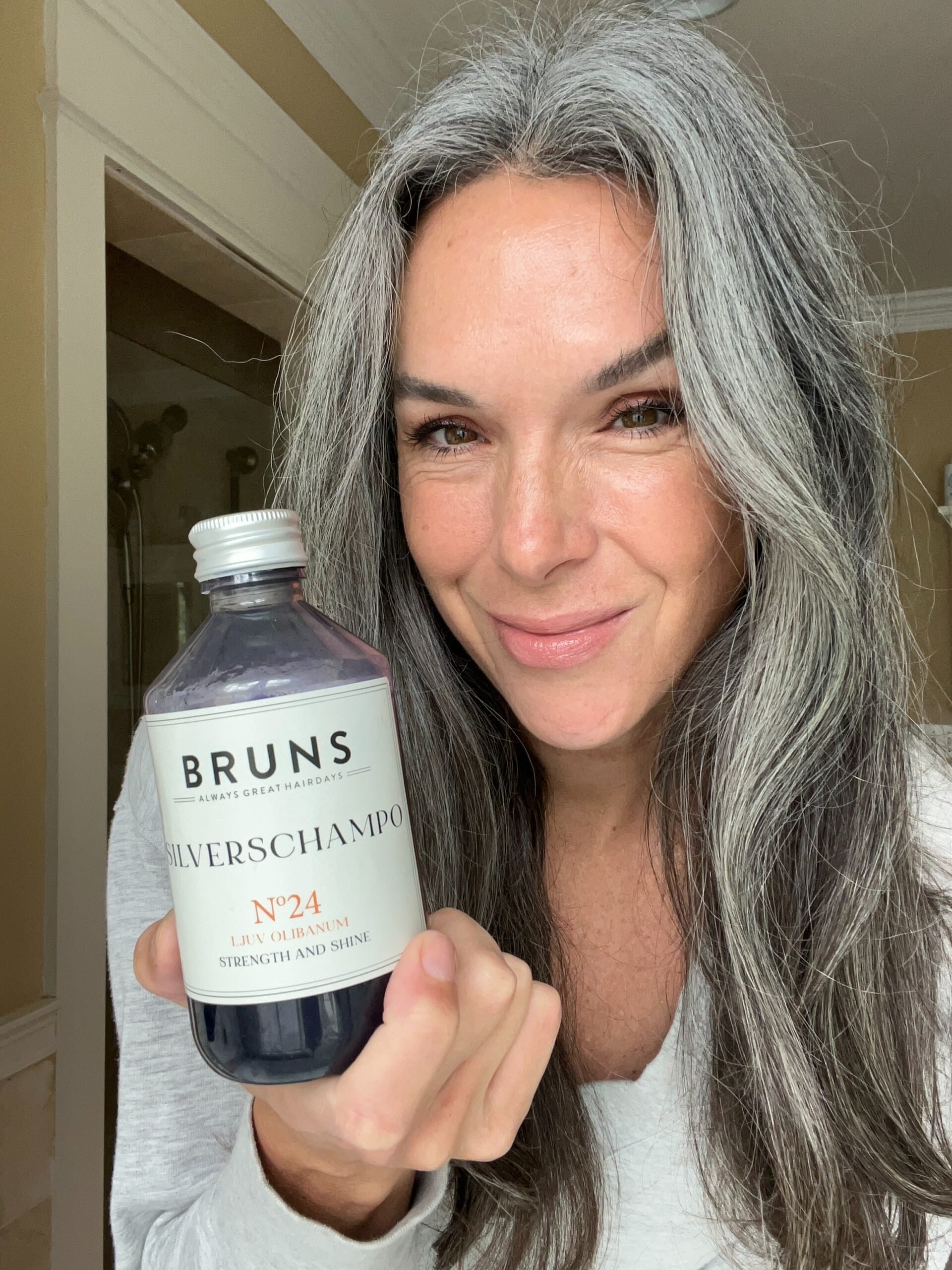
By: Lisa Fennessy
IN THIS POST:
- Why does gray or silver hair get brassy?
- Reduce brassiness with a UV + heat protectant
- Other preventative measures to stop yellowing or brassiness
- Why use purple shampoo?
- The active ingredients in purple shampoo
- How to use all-natural purple shampoo
- How to find the right purple shampoo for you
- The best all-natural purple shampoos
- All the purple shampoos I’ve tried, with before & after pics
- After reading this, most people bought…
- Common questions about purple shampoos for gray hair
Confession: The first couple of years I grew out my hair gray, I was convinced my experience transcended purple shampoo. Actually, it was more like I was running an offense for the “just use regular shampoo” team. I was fine rotating through my roster of favorite clean beauty shampoos. They were cleaning my hair per usual and everything was fine. Until it wasn’t.
RELATED: Gray hair, do care—why to ditch the dye.
About three years into my growth, my hair started taking on a brassy tinge. I couldn’t tell if my whites were actually white or if they were browns that hadn’t turned white yet. It was all getting a bit muddy and I found myself craving something to add brightness, definition, brilliance and clarity to my grays.
And then it dawned on me. I probably need a purple shampoo! Here’s why.
Why does gray or silver hair get yellow or brassy?
Jenn Jones, master colorist and owner of Creature Studio in Atlanta, explains, “Light colored hair like shades of blonde and gray are more susceptible to becoming discolored due to a number of factors like heat styling, medications, product buildup, sun, salt, chlorine and environmental pollutants.”
And she’s right. In fact, UV and heat are the biggest discoloring factors. Research has demonstrated UV turns proteins in hair yellow. Melanin in hair normally prevents hair from yellowing, but gray and silver hair have little to no melanin content to prevent this.
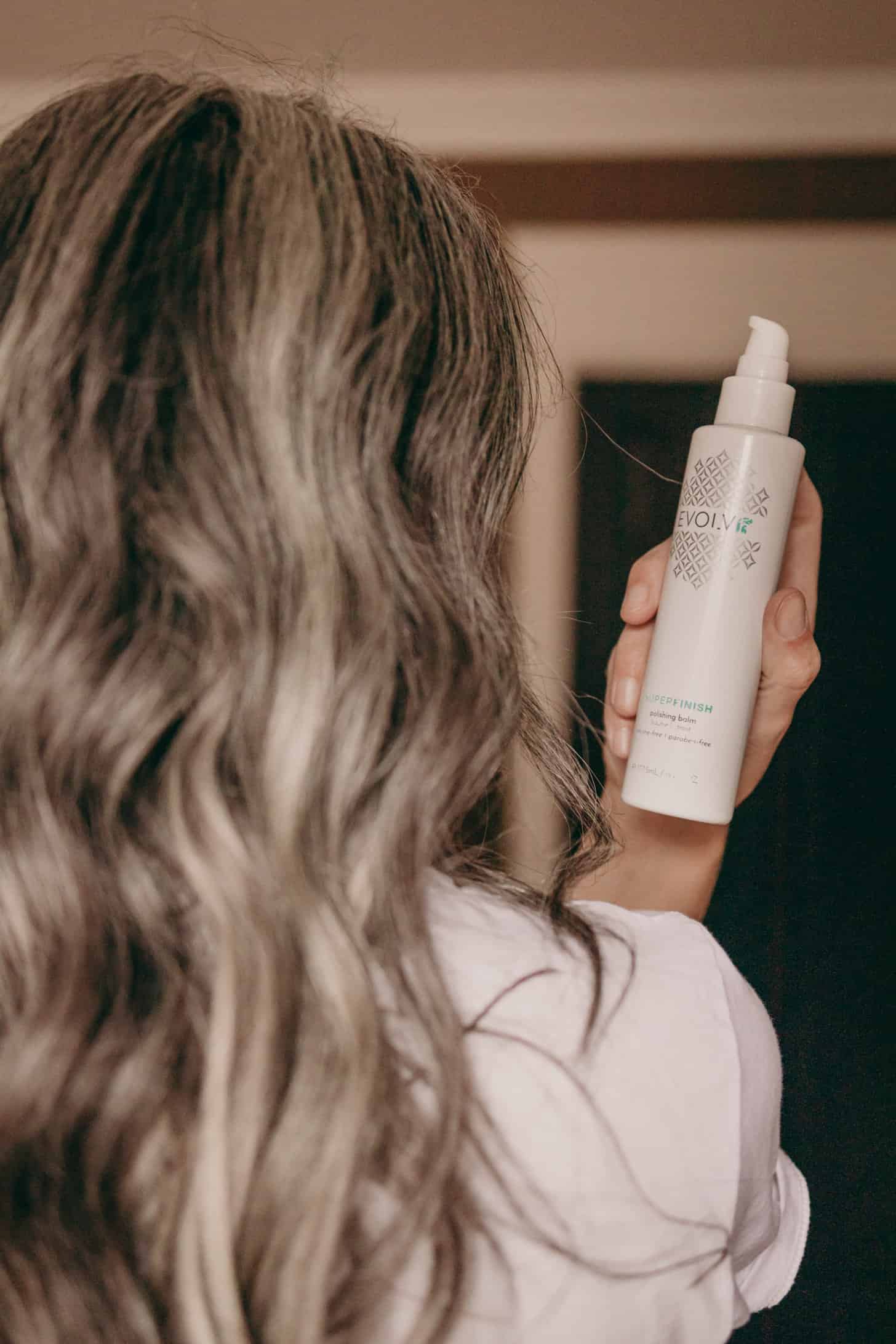
Help reduce brassiness with a clean UV + heat protectant
Using a heat + UV protectant, along with a great purple shampoo, can be incredibly effective at bringing out those white, bright silver and grays—it basically helps stop the yellowing/brassiness before it starts.
I’ve tried a number of ethical beauty heat protectants (read about my full experience, and get full reviews of all the ones I’ve tried here), and hands down, the best one is EVOLVh’s Superfinish Polishing Balm.
The Polishing Balm stands out to me because it’s water-based and really light and it doesn’t change the texture of my hair. It’s like adding nothing but it’s like adding everything. Check it out: the Polishing Balm defrizzes, adds moisture, softness, shine, strength, prevents breakage, splitting AND provides UV and heat protection. I know. I KNOW!
I add a dollop of this to my hair before every blow dry and it leaves my hair super shiny and soft. #obsessed
Code: NEWKNEW15 will save you 15% on your first order at EVOLVh here!
RELATED: Read my review on the best heat protectant for gray hair and beyond.
Other preventative steps to stop yellowing or brassy hair
We can’t control the melanin in our hair, but we can control any external factors that cause yellowing or brassiness—like the products we choose to use.
Product buildup is a big factor when it comes to yellowing. To avoid it, choose EDTA-free shampoos, which can specifically cause yellowing.
Another preventative measure is to look for shampoos that are rich with plant antioxidants, which help reduce yellowing caused by UV. Antioxidants that are most effective for stopping hair yellowing (UV, heat, iron in water) are the ones that quench the hydroxyl radicals that are causing the yellowing. These are plant sugars like mannitol, quercetin and purple pigments in grapes and cranberry, to name a few.
And since I mentioned it, reducing your exposure to UV rays is key to preventing yellowing of strands. Molecular Biologist and Cosmetic Chemist Kate Noonan explains that hair is made up of 95% keratin protein. When hair is exposed to UV, it breaks down that keratin—specifically the part that gives hair its strength and shine. UV also fades hair color and can create hair-yellowing. Using a hair sunscreen can help with this—and these are my top picks (you know I got you, girl).
Reducing your use of heat tools like flat irons, curling irons and blow dryers can also significantly reduce yellowing of your hair. Too much heat on gray hair can turn it brassy (or yellowish). That leaves you with a few options:
- Stop using heat tools, and when you do, make sure it’s continually in motion (aka, don’t hold your blow dryer stagnantly on one section of your hair).
- Choose heat tools that dry or style your hair in half the time, like the Dyson Supersonic Hair Dryer. It also has controlled heat settings that help reduce damage. Not sure if it’s for you? Check out my GRWM video here to see how FAST it dries hair.
- Skip heat all together and opt for a heatless styling tool! We’ve been testing a BUNCH of heatless curling options, so stay tuned for our review of the first, dropping later this week!
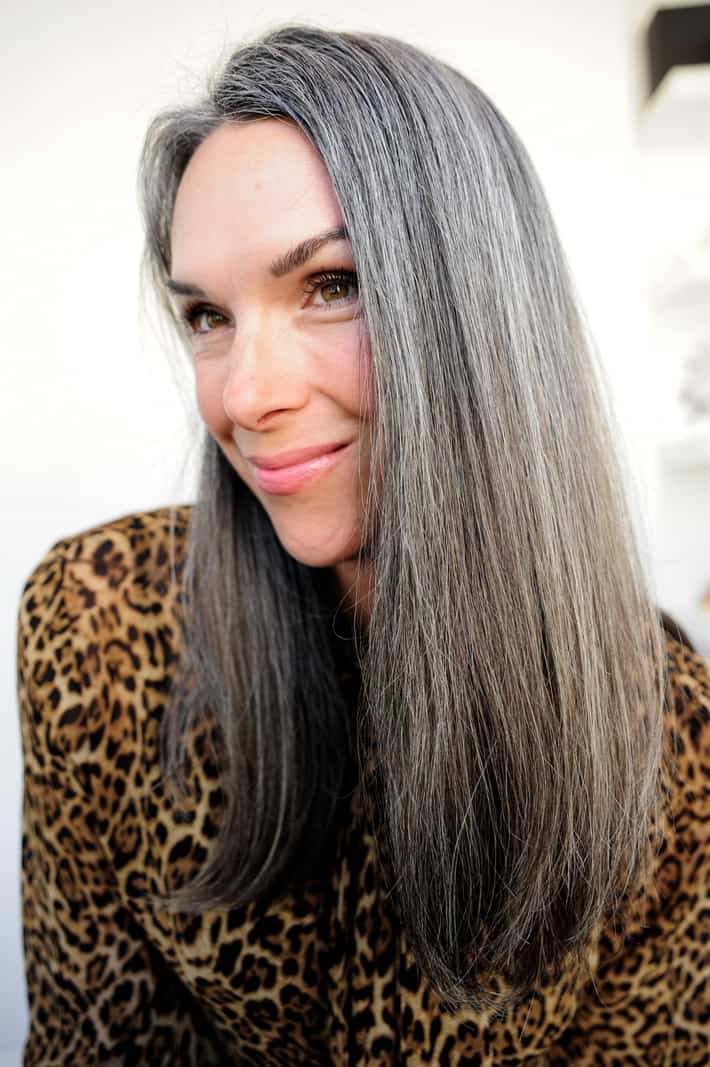
Why use purple shampoo?
Okay, now on to the purple shampoo! Purple shampoo is actually another preventative measure, but it merits a bit of an explanation, so we are dedicating this entire post to taking a deeper look.
Purple shampoos are called “purple shampoos” because they are actually…PURPLE. Jenn adds, “It’s basic color theory. Purple and yellow are complementary colors. That means when put together, they neutralize each other. These shampoos are going to get rid of unwanted yellow or ‘brassy’ tones in light shades of hair so the hair is left brighter.”
This is DIFFERENT than the chelating or clarifying shampoo, or apple cider vinegar rinses you might have heard of. A chelating or clarifying shampoo can be used to remove any product or mineral buildup that may be contributing to brassiness. ACV is typically used after you shampoo, condition or color because it seals the cuticle down and adds some shine.
What are the active ingredients in purple shampoo?
So the bottom line is that you need something purple in the purple shampoo to get the job done. I’ve seen brands use a myriad of ingredients to attempt this, from botanicals like purple potato, to mineral-derived pigments like ultramarines and iron oxides, to plant extracts like bilberry extract and beet extract, to synthetic dyes (like Basic dyes and Acid Violets). And in a nutshell, I’ve found that the purple shampoos that use vegetable and botanical extracts are a lot less effective compared to purple shampoos that use synthetic dyes.
So then the obvious next question is, what’s the deal with synthetic dyes and do we need to be concerned with using them? Let’s break them down by category to dive in deeper.
Basic Dyes
Basic Dyes (which is actually the proper name for these dyes even though it sounds like a descriptor—”Basic dyes” can encompass everything from Basic Brown 16 to Basic Blue 99 and Basic Red 76, the two we’re specifically talking about here) fall under the category of “coal tar” dyes, which means they are exempt from FDA approval. Coal tar dyes are synthetic dyes and contain petrochemical derivatives.
From what we can see, each of the Basics comes with its own set of things to consider, some of which we highlight in our look at Overtone.
For example, we checked in with clean cosmetic chemist, Ayurvedic practitioner and founder of KKT Consultants, Krupa Koestline, who explains, “Basic Blue 99 [what we see in some purple shampoos] has been determined okay to use by the Cosmetic Ingredient Review Expert Panel (CIR) and the EU Safety panel, but have noted that the structure and composition can vary quite a bit and so that can be an issue if not properly tested.”
She continues, “Basic Red 76 [also what we see in some purple shampoos] is an ‘azo-dye’. Basic Red 76’s safety in use is inconclusive per [the] EU. The Scientific Committee on Consumer Safety (SCCS) in an Opinion, SCCS/1385/10, has classified Basic Red 76, when used as a non-oxidative hair dye up to 2%, as not posing a risk for consumers. However, Australia doesn’t allow the dye and differs in opinion. The concern is the presence of o-ANISIDINE, which is a carcinogen.” The muddy waters around this specific issue are also illustrated in this challenge paper.
Like with anything, it’s about the quality of the ingredients, the percentage of the ingredient and how much you trust the company making the product. Which leads us back to marketing lingo, greenwashing and transparency.
Takeaway: Do I want to drink this? No. Am I okay with using a tiny percentage in my purple shampoo? Yes, I am.
Acid Violets
Violet 2 (also known as Ex D&C Violet 2) and Acid Violet 43 used to be derived from coal tar, but are currently made during petroleum jelly refining. They routinely bear a “caution” statement regarding potential skin irritation and instructions for determining whether the product causes skin irritation in any given individual, so I wanted to do a little digging to see why.
Krupa explains, “Acid Violets are safe to use and don’t have any safety issues associated with them, in hair shampoo/conditioner application. They are both not recommended to be used on mucous membranes, but otherwise no other concerns.”
In some additional research and with help from Kate, we were able to add a little more color.
- Both Violet 2 and Acid Violet 43 are not mutagenic in any of the tests like the Ames test or the micronucleus assay.
- Violet 2 in a 1% concentration shows no system toxicity and no significant local skin reactions.
- Acid Violet 43 was determined to be safe for use in hair dye formulations, when impurities are limited. The Scientific Committee on Consumer Safety is of the opinion that the use of Acid Violet 43 as a non-oxidative hair dye with a maximum on head concentration of 0.5% active dye does not pose a risk to the health of the consumer.
- The CIR (the US Cosmetic Ingredient Review panel) found that no dermatitis was seen when many human volunteers at different Derm centers had 1% Acid Violet 43 in petrolatum applied to their skin over a 6-month period.
To put all this in context, Kate explains, “Often, just a 0.3% concentration of Acid Violet is needed to treat hair brassiness.”
Takeaway: With all that in mind, the concentration of dyes like Acid Violet 43 and Violet No. 2 that we find in the purple shampoos I’m trying and recommending are considered safe, both by the FDA and by my trusted cosmetic chemist sources.
Plant-derived “botanical” dyes in purple shampoo
The FDA classifies color additives obtained primarily from mineral, plant or animal sources as “not subject to batch certification requirements.” This means that the FDA doesn’t need to review each batch of these colorants, and that cosmetics companies can include them without having them reviewed by the FDA’s certification. But, says the FDA, they “still are considered artificial colors, and when used in cosmetics or other FDA-regulated products, they must comply with the identity, specifications, uses, restrictions, and labeling requirements stated in the regulations.”
Takeaway: Again…this comes down to the transparency of the brand and how much you trust their practices. A trustworthy brand will do its research and comply with regulations, as well as provide clarity on the ingredients in its products.
Should I use blue shampoo for my gray hair?
NO. Purple shampoo is not to be confused with blue shampoo, which is used for darker hair to cancel out orange tones. Jenn warns, “Never put blue, even pale blue, on blonde hair when trying to cancel out yellow tones. Blue + yellow = GREEN.”
How to find an all-natural purple shampoo that’s right for you
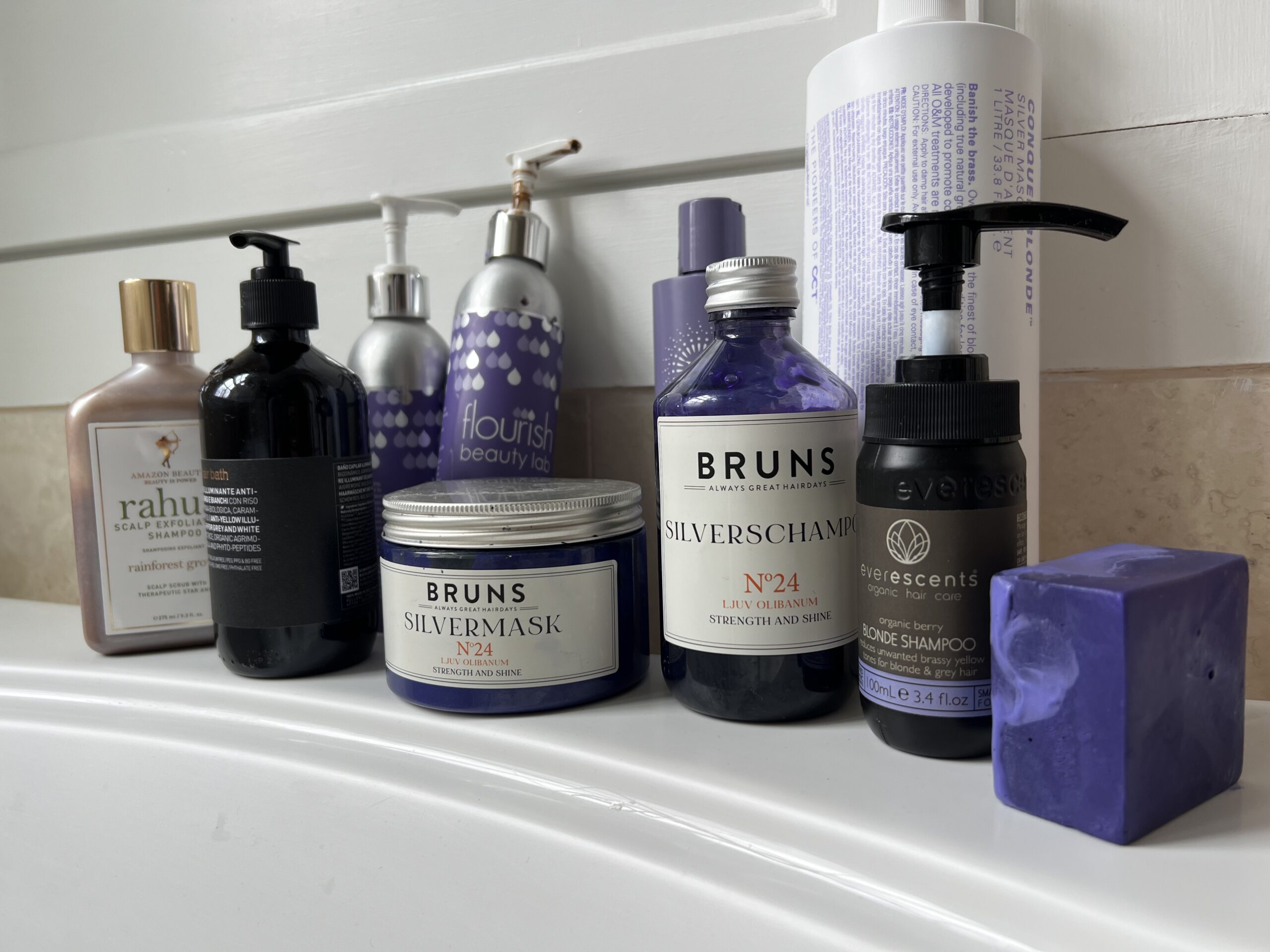
MOST of the purple shampoos on the market are formulated with other health-compromising ingredients like surfactants, parabens, fragrance and more, like DMDM Hydantoin. DMDM Hydantoin is a formaldehyde-containing ingredient and it’s sometimes listed (sometimes not if it’s hidden in a surfactant).
BUT! I was able to hunt down a few cleaner options that are formulated without all the junk. Purple shampoo is currently an incredibly niche piece of the clean beauty market (though it’s rapidly expanding, as evidenced from the new formulas I’ve recently tried), and each brand I’ve found formulates a bit differently.
Finding a “right fit” purple shampoo is really about taking into consideration your own type of hair and balancing that with how aggressive of a treatment you want. What it really comes down to in the end, as always, is making an educated decision about what you personally want.
How do I use all-natural purple shampoo?
If you’ve tried using purple shampoo to brighten your gray (or blonde) hair, but it doesn’t work—you *might* be doing it wrong. The trick? You have to leave it in and let it actually tone your hair!
Of course potency and efficacy can vary from brand to brand depending on percentages and ingredients, but if the question is “Does purple shampoo work?” the answer is YES, AND (!!) if it’s not working for you, you most likely are not giving the pigment enough time to transfer.
The best way to use clean beauty purple shampoos is:
- Apply on wet hair in the shower.
- Wash hair as normal, but don’t rinse.
- Let the shampoo sit on your hair for a few minutes (sometimes directions even say this explicitly) before rinsing. You can even take a clip into the shower and clip up your hair as you take this time to do all the other things like wash your face or shave. This gives the color a chance to work so you are not applying it and rinsing it off straight away.
- Once you’ve let it sit, rinse out and conditioner like normal.
Here’s a quick video of me trying out my favorite brand or purple shampoo…
You will also have to play with frequency, depending on how often you wash your hair and the needs of your own gray hair. For the person who washes daily, you may only need to use a purple shampoo a couple times a week to get those grays non-brassy and bright. Or for the person who only washes their hair once a week, you may be able to use a purple shampoo every time you wash.
It also depends on the shade of your hair. Jenn explains, “Anyone can use a purple shampoo; you just won’t get benefits from the color unless your hair is a level 8 [a medium blonde on the hair tone scale] and above. The pigment is just not strong enough to do anything to darker tones.”
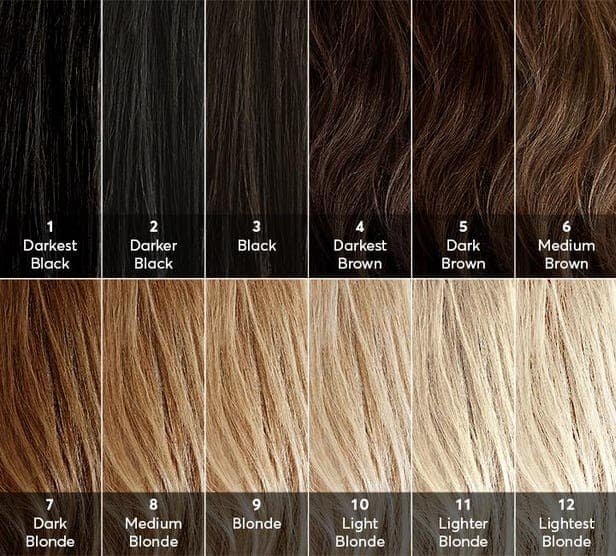
The goal here is to determine your own personal equation of frequency, taking into consideration shampoo formula, hair type, hair shade, hair texture and personal washing frequency.
What if my hair turns purple?
If your hair happens to turn purple, Jenn suggests that “a clarifying shampoo will typically work well to pull out unwanted tones. You can apply the shampoo and let it sit for a while to help pull out the color. Typically, if your hair is over-processed or porous, the color can build up, usually on the ends, and be harder to get out.”
The best all-natural purple shampoos
I’m going to use this space to document the purple shampoos I’ve tried that I would consider to be the cleanest options available. I’m starting with my top two recommendations by hair type and I will continue to add reviews here as I try more product. Comment below if you have an option I didn’t include here!
Top purple shampoo pick for thick, dense, oily hair
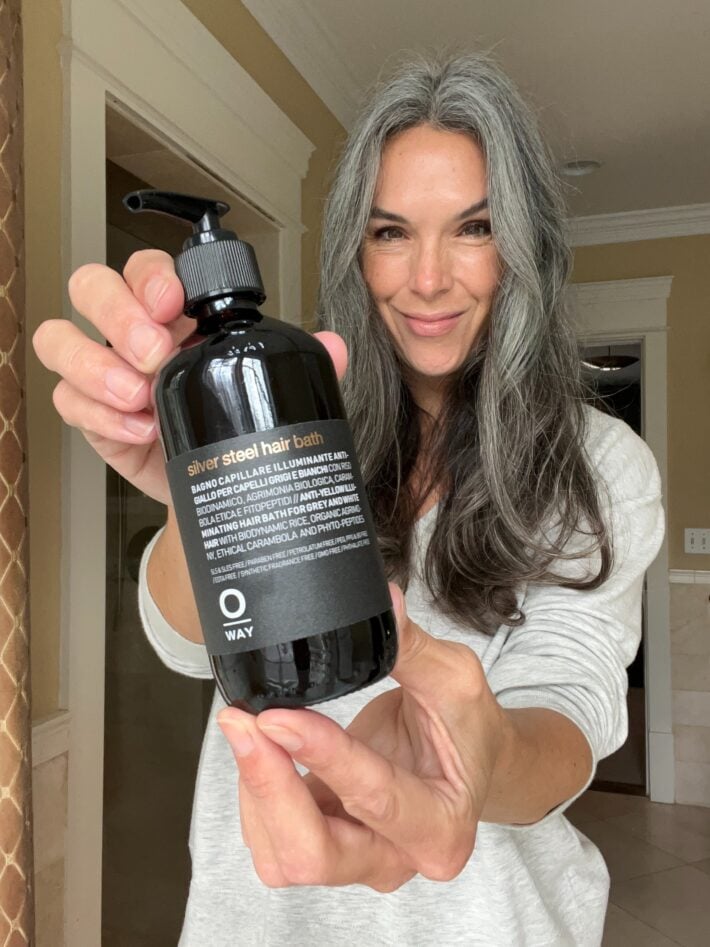
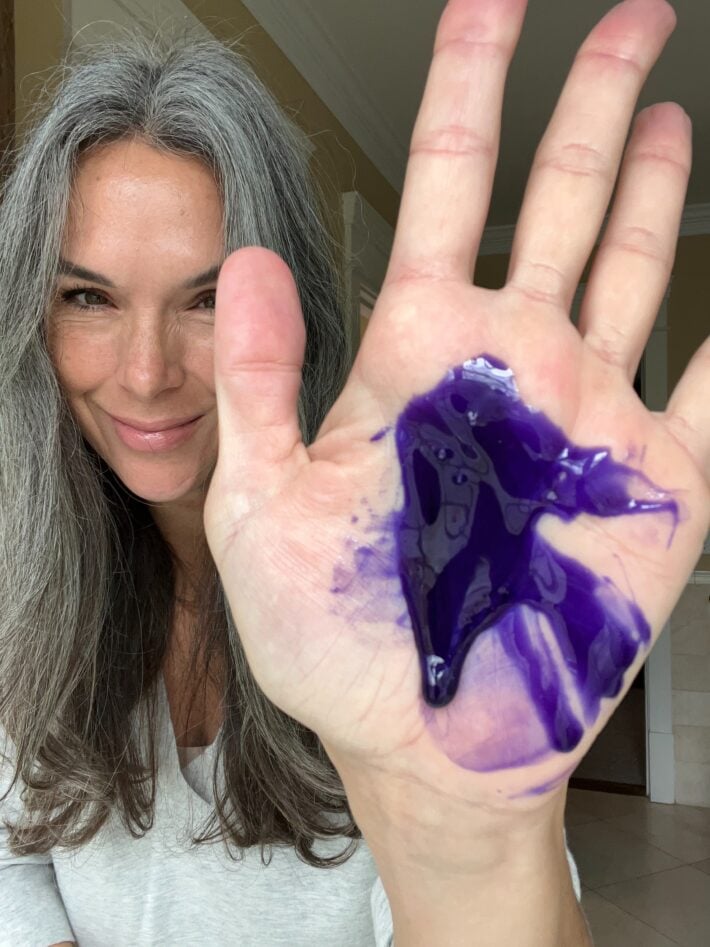
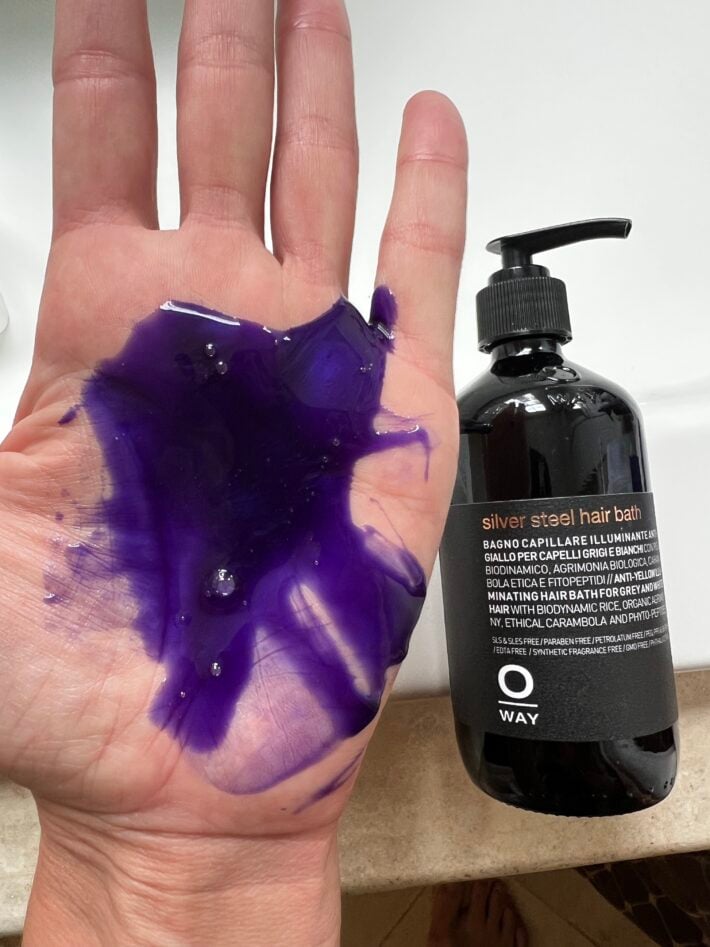
OWAY Silver Steel Hair Bath | $45.95
I’m going to come right out and say it: I love using OWAY’s Silver Steel Hair Bath. It smells great and leaves my hair feeling fresh, bouncy and clean. It’s also packaged in glass, which is RARE for any shampoo. Most brands won’t do this for safety reasons, but I love it. It feels elevated and chic. Also…yay for less plastic.
This formula pumps out a dark, iridescent, royal purple. It cleans really well and is great at removing oils and buildup. I found this shampoo at the salon I go to, so it’s no surprise that it works. And when I say it works, it not only cleans hair, but it also reduces brassiness like a boss. Take a look at the before and afters on this blonde wig.
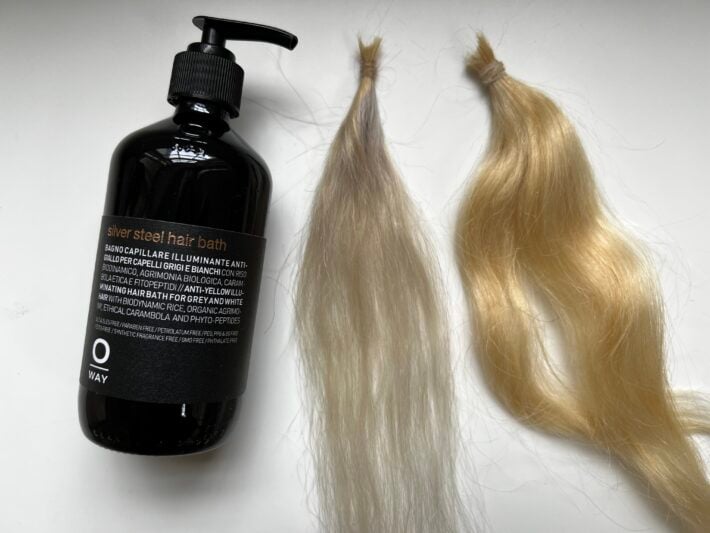
Silver Steel Hair Bath uses Violet 2 as a pigment to neutralize brassiness and I would classify this formula as the strongest purple shampoo I’ve tried in terms of toning power. Even when I took the pic with this product on my hand, it stained my hand purple for about an hour or so after that.
But outside of the fact that #itworks, what really turned me on to Silver Steel Hair Bath is that it’s stacked with nourishing hair ingredients like resurrection plant.
Resurrection plant the same ingredient we see in African Botanics’ Resurrection Cell Recovery Serum. It has the ability to survive in extremely harsh, dry conditions and has a regenerating, anti-oxidative, moisturizing and protective effect on the hair, skin and scalp. The formula is also rich in phytonutriens, and vitamins A, B and C, as well as hyaluronic acid, antioxidants and minerals.
As far as the scent goes, there is no one note that stands out to me here, but it has a light, spa-like scent.
Ingredients: Water (ND), Sodium Coceth Sulfate (ND), Cocamidopropyl Betaine (ND), Magnesium Sulfate (ND), Averrhoa Carambola Fruit Extract (FT), Agrimonia Eupatoria Extract (O), Oryza Sativa (Rice) Extract (B), Pisum Sativum (Pea) Peptide Sativum (Pea) (ND), Leuconostoc / Radish Root Ferment Filtrate (ND), Sodium Babassu Amphoacetate (ND), Coco-glucoside(ND), Glycerin (ND), Macadamia Seed Oil, Glycereth-8 Esters (ND), Juniperus Virginiana Wood Oil (EO), Citrus Medica Limonum (Lemon) Fruit Oil (EO), Eucalyptus Globulus Leaf Oil (EO), Citrus Sinensis Peel Oil Expressed (EO), Citrus Aurantifolia (Lime) Oil (EO), Laurus Nobilis Leaf Oil (EO), Pelargonium Graveolens Flower Oil (EO), Cinnamomum Camphora (Camphor) Bark Oil (EO), Citrus Aurantium Bergamia (Bergamot) Fruit Oil (EO), Juniperus Virginiana Oil (EO), Cananga Odorata Flower Extract (ND), Citrus Aurantium Dulcis (Orange) Peel Oil (EO), Verbena Officinalis Leaf Extract (ND), Citrus Aurantifolia (lime) Peel Oil (EO), Acacia Decurrens Dealbata Flower Extract (ND), Santalum Album (Sandalwood) Oil (EO), Jasminum Officinale (Jasmine) Oil (EO), Citrus Aurantium Flower Oil (EO), Rosa Damascena Flower Oil (EO), Lavandula Angustifolia (Lavender) Oil (EO), Cymbopogon Martini oil (EO), Lavender Hybrida Oil (EO), Glyceryl Oleate (ND), CI 60730 (Ext. Violet 2), Polyquaternium-10, Hydrogenated Palm Glycerides Citrate (ND), Disodium Laureth Sulfosuccinate (ND), Glycol Distearate, Citral Acid (ND), Sodium Chloride (ND), Tocopherol (ND), Sodium benzoate.
Top pick for mature, thin, drier hair
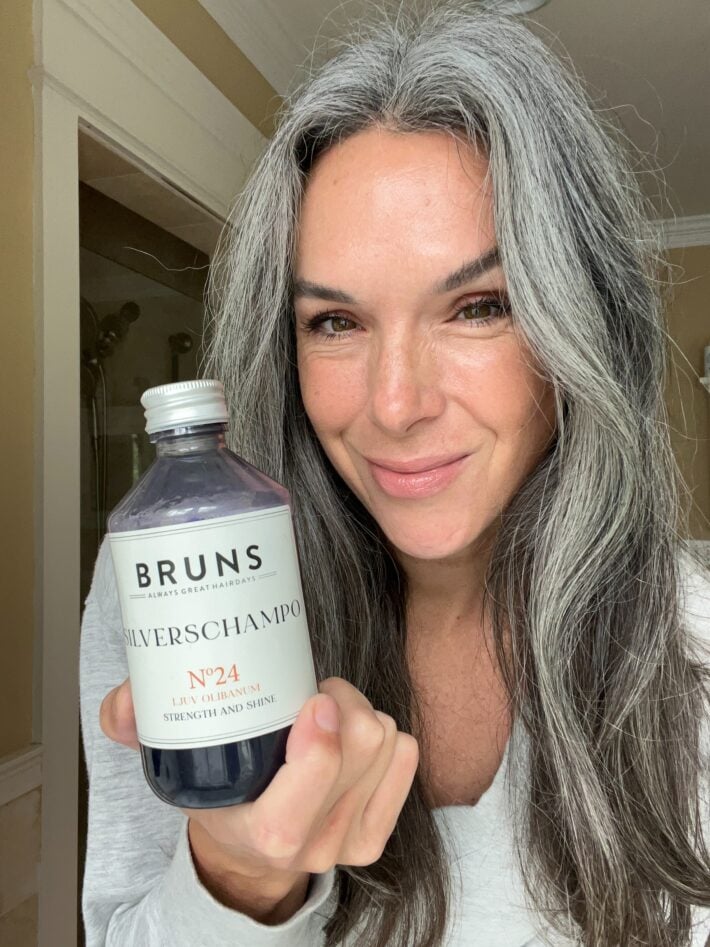
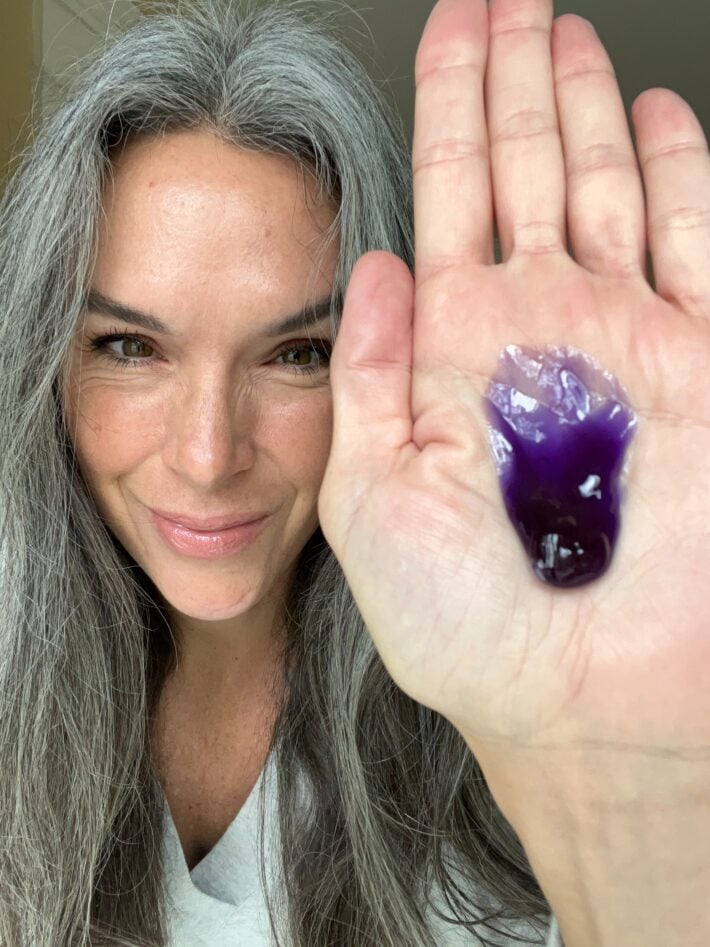
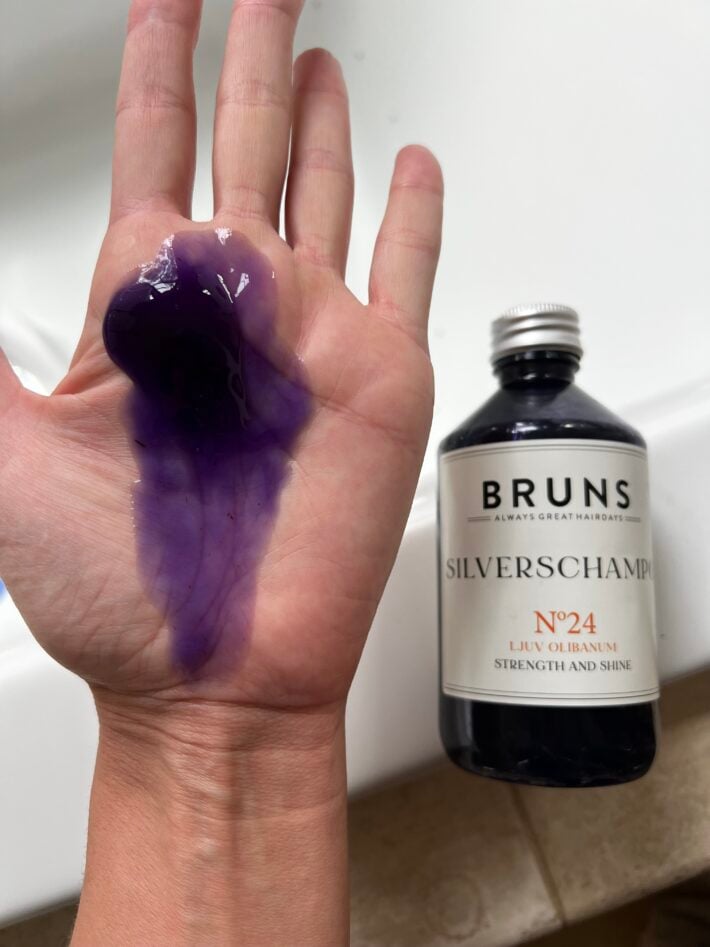
Bruns SCHAMPO N24 | $39
This formula was recommended to me by one reader on Instagram—THANK YOU! I was so so so excited to give this option a try. In terms of ingredients, this is BY FAR the simplest formula I’ve seen to date. To be honest, I was kind of borderline shocked at the brevity of the ingredient list. It left me looking at the label like, Where’s the rest of the ingredients?
SCHAMPO N24 is packaged in plastic and squeezes out a medium, translucent purple. I would equate the consistency, color and texture to be like that slime kids get out of a $0.25 machine. A demi-translucent jelly, if you will.
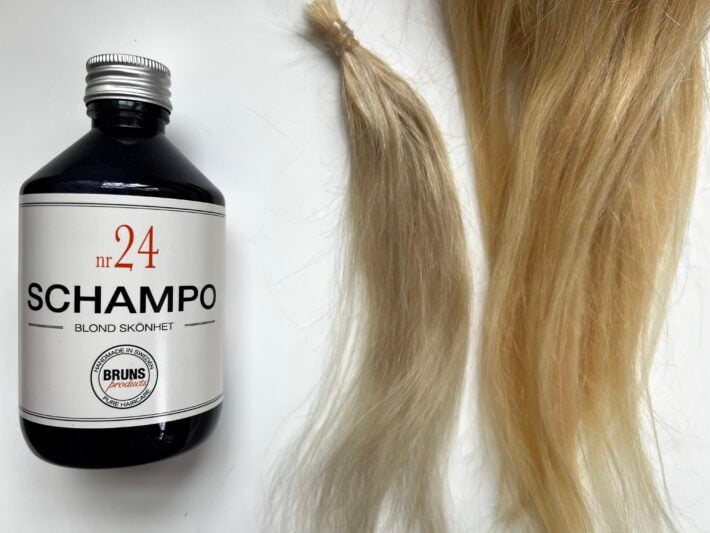
This shampoo is on the mild end of the spectrum—mild in cleansing power and milder in pigment. It didn’t stain my hand when I took these pics (like OWAY’s did) and it’s gentle enough to use every day. It works to clean without stripping or drying out hair, which is great considering hair gets naturally drier as we age. Especially gray hair!
It also has ingredients like jojoba oil to add protection against dryness, breakage and split ends, and grapefruit essential oil, which helps relieve scalp irritation. As far as antioxidants go, the campeachy tree also works to make the same purple pigment grapes/berries make and it makes quercetin too.
Kate adds, “The BRUNS shampoo looks really good because the pH is ideal for hair and scalp—I can tell what the exact product pH must be by their Ecocert COSMOS preservative choice. They also use the COSMOS cationic guar, which reduces friction between strands, is scalp-friendly and works to keep hair strong. Here’s a cool article that mentions the importance of a low pH shampoo for hair.”
I have thicker hair, but I’ve actually come to love this option because I can use it all the time without fear of giving myself straw head. It also has a lovely grapefruit/citrus scent.
SCHAMPO N24 uses naturals (campeachy tree) and synthetics (Acid Violet 43) as pigment to neutralize brassiness. (They also have an awesome purple hair mask too, which is insane and works so well to moisturize and tone hair at the same time. Check them both out here!)
Ingredients: Aqua, Decyl Glucoside, Glycerin, Olive Oil Polyglyceryl-6 Esters, Sodium Laurylglucosides Hydroxypropylsulfonate, Disodium Cocoyl Glutamate, Simmondsia Chinensis Seed Oil, Xanthan Gum, Hydroxypropyl Guar, Haematoxylum Campechianum Powder, Parfum**, Boswellia Carterii Oil**, Citrus Paradisi Peel Oil**, Cymbopogon Citratus Leaf Oil**, Citral***, Linalool***, Limonene***, Glyceryl Laurate, Potassium Sorbate, Pentylene Glycol, Sorbic Acid, Acid Violet 43*. *synthetic origin **essential oils ***natural components in essential oils
All the purple shampoos I’ve tried (with before & after pics!)
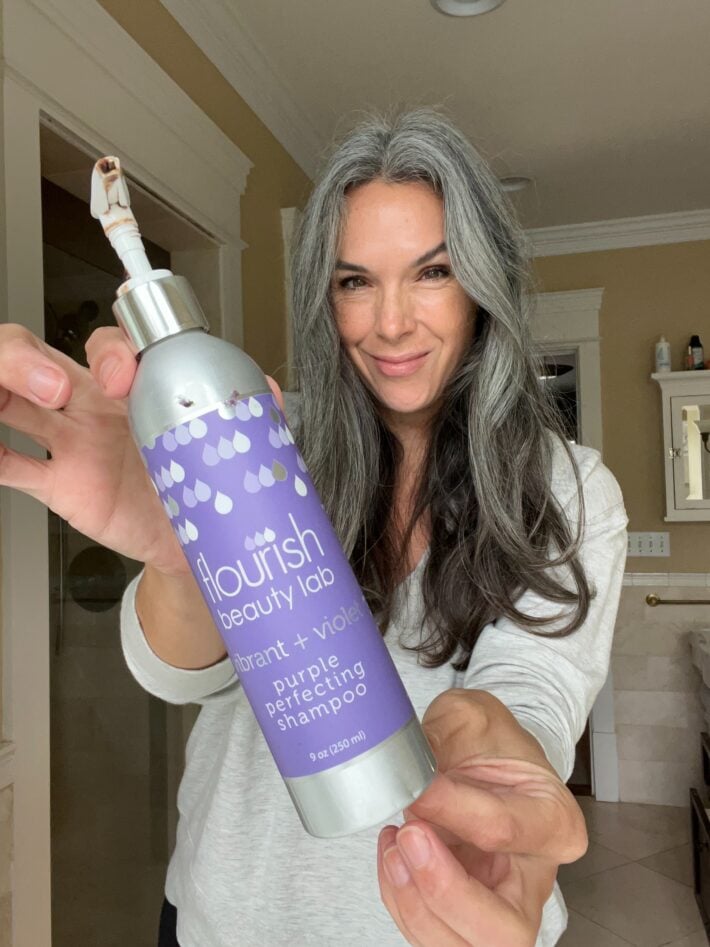
Flourish Vibrant + Violet Purple Perfecting Shampoo | $36
This is a top pick for people with sensitivities and/or allergies to synthetic dyes. Created from certified organic, wild harvested and Ecocert ingredients, this plant-based shampoo is tinted with beet extract, bilberry extract, rhubarb extract and more to get its purple hue. There is also the option to add a dried plant mix called a Violet Booster for a more pigmented experience. I used it both with and without.
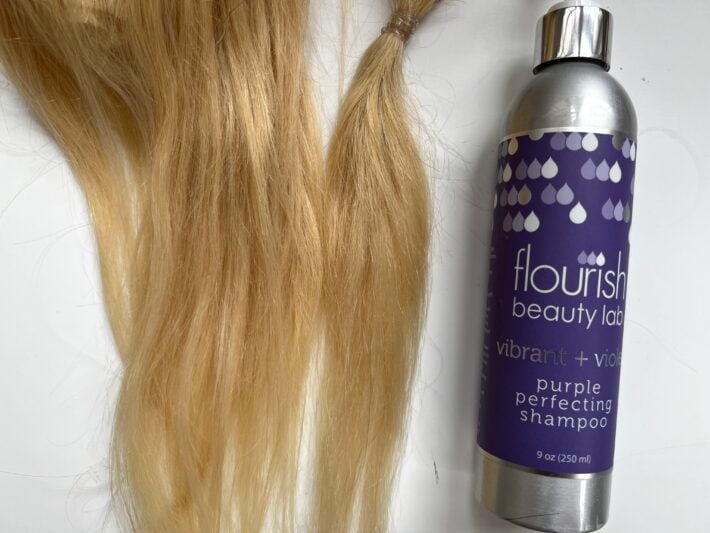
I finished the bottle (on this blonde wig) before I could snap a pic to show you the color—oops. But it cleans hair well, smells good and is sustainably packaged. My only personal hangup is I didn’t see that much of a brightening effect from these ingredients. I also found that it oxidized over time, becoming less purple as it aged.
BEST FOR: Someone with chemical sensitivities or purists who want something as close to nature as possible.
Ingredients: purified water (and) Rosa canina (rosehip)extract (and) helianthus annus (sunflower) seed extract, decyl glucoside***, sodium lauryl sulfoacetate***^, vegetable glycerin*, propanediol***, (and) proprietary color blend of spirulina platensis (spirulina), beta vulgaris (beet) extract, vaccinium myrtillus (bilberry) extract, rheum palmatum (rhubarb) extract, ribes nigrum (black currant)extract, gluconolactone***(and) sodium benzoate***(preservative system), guar hydroxypropyltrimonium chloride, panthenol (vitamin B), secret essential oil blend including violet leaf. VEGAN. GLUTEN+NUT FREE. *certified organic ** wild harvested ***Ecocert ^safe, gentle cleanser, not SLS
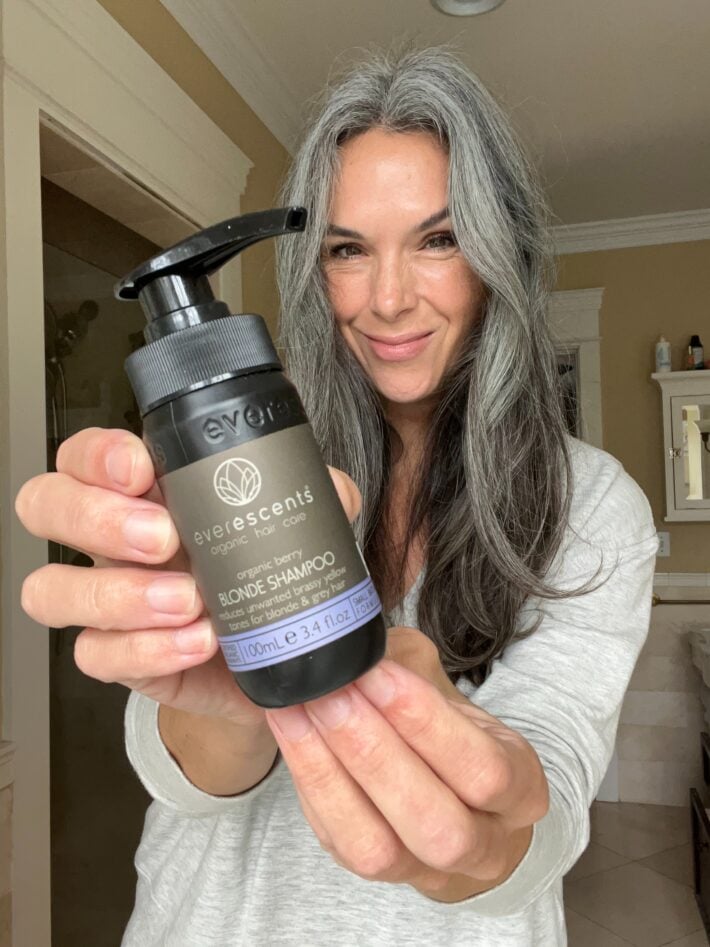
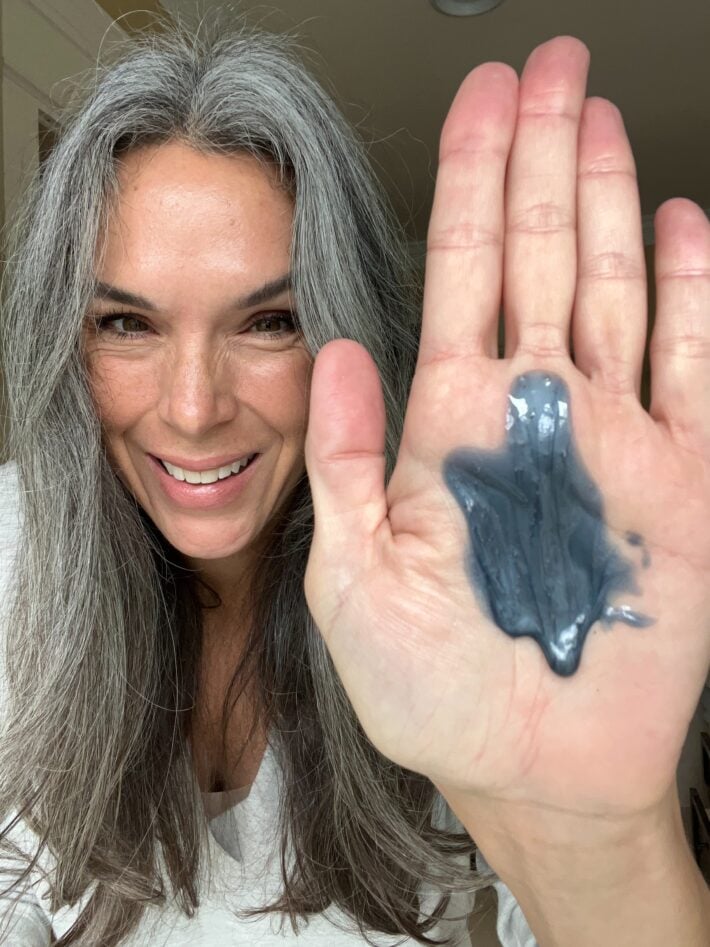
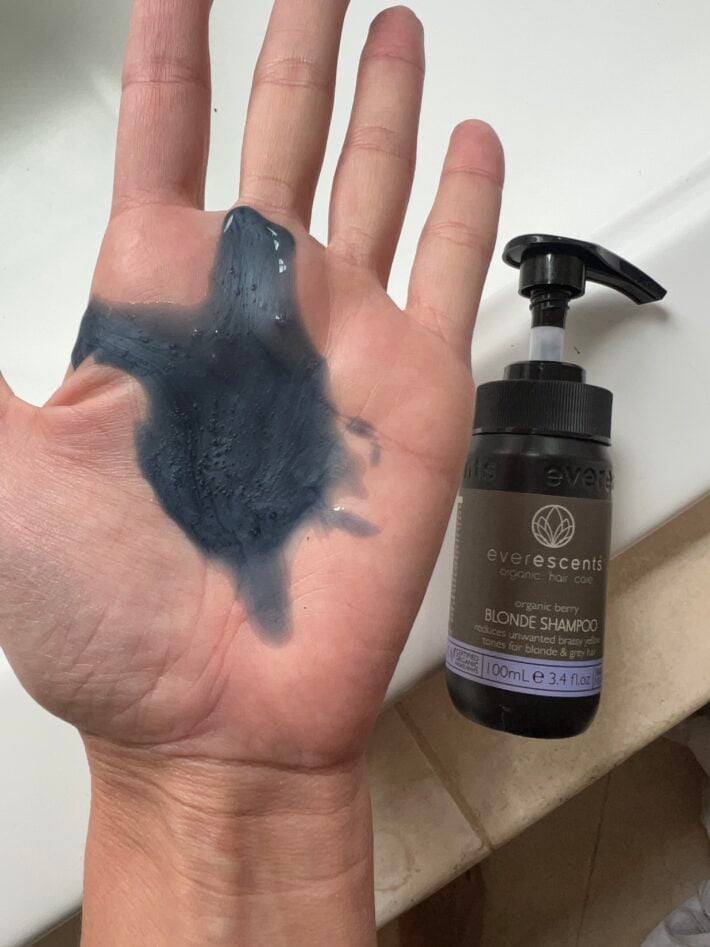
EverEscents Organics Berry Blonde Shampoo | $32.95
This is another option for people who don’t want to use synthetic dyes. EverEscents uses a mix of red sweet potato and blue gardenia to tint their Organic Berry Blonde Shampoo.
What really drew me to this formula is that it’s made from 83.8% certified organic ingredients and 99.36% naturally derived ingredients. But you will see the color here is more of a gray metallic rather than a vibrant violet/purple, which leads me to my next point.
This is not *really* a purple shampoo in the traditional sense of purple shampoos. And EverEscents confirms. They say this shampoo is designed to “maintain the tone in between salon visits.” (Not to “overtone” hair.) They also say that because it’s not meant to tone hair, it’s a good fit for all hair types and all colors.
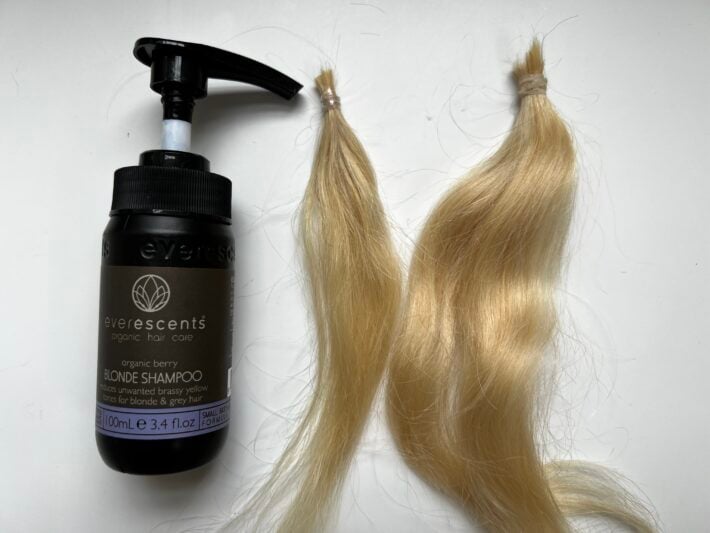
This shampoo is not designed to neutralize brassy tones in your gray hair. If you want THAT, you have to buy something that is designed to do THAT.
To be honest, my favorite thing about this shampoo is that it washed my hair as good as any conventional shampoo ever has. The “clean hair” satisfaction score here is off the charts. It left my hair feeling fresh and bouncy, but after using it for a few weeks, it also left my hair and scalp feeling dry.
The other drawback is that it’s not available in the US. I ordered this from Australia and paid about $40 in shipping alone for this 8oz bottle.
The scent here is like an old school box of Nerds—very sweet and grape-y, which I personally dig.
BEST FOR: Someone with oilier hair who is trying to maintain their hair color in between salon visits.
Ingredients: Certified Organic Aloe Barbadensis (Aloe Vera) Leaf Juice*, Glycerin* (moisturiser), Coco-Betaine** (foaming agent derived from coconut oil), Sodium Lauroyl Methyl Isethionate** (sulfate free mild cleansing agent derived from renewable resources), Sodium Methyl Cocoyl Taurate (mild cleansing agent derived from coconut oil), Glycol Distearate** (emollient / thickening agent), Rosmarinus Officinalis (Rosemary) Leaf Extract*, Salvia Officinalis (Sage) Leaf Extract*, Tilia Cordata (Linden) Flower Extract*, Urtica Dioica (Nettle) Extract*, Betula Alba (Birch) Bark/Leaf Extract*, Equisetum Arvense (Horsetail) Extract*, Achillea Millefolium (Yarrow) Extract*, Panthenol Vitamin B5** (strengthens against breakage and nourishment for hair and scalp), Tocopheryl Acetate Vitamin E** (keeps hair flexible), Natural Mixed Berry Flavour**, Citric Acid** (natural preservative), Maris Sal (Sea Salt)**, Polyquaternium-10** (mild thickening agent derived from wood fibre), ((Benzyl Alcohol, Potassium Sorbate, Sodium Benzoate); mild preservative approved for use in Certified Organic formulas), Ipomoea Batatas (Red Sweet Potato) Root Extract **(natural colour), Gardenia Jasminoides (Blue Gardenia) Fruit Extract ** (natural colour).
*CERTIFIED ORGANIC INGREDIENT **NATURALLY DERIVED INGREDIENT
83.80% CERTIFIED ORGANIC INGREDIENTS 99.36% NATURALLY DERIVED INGREDIENTS
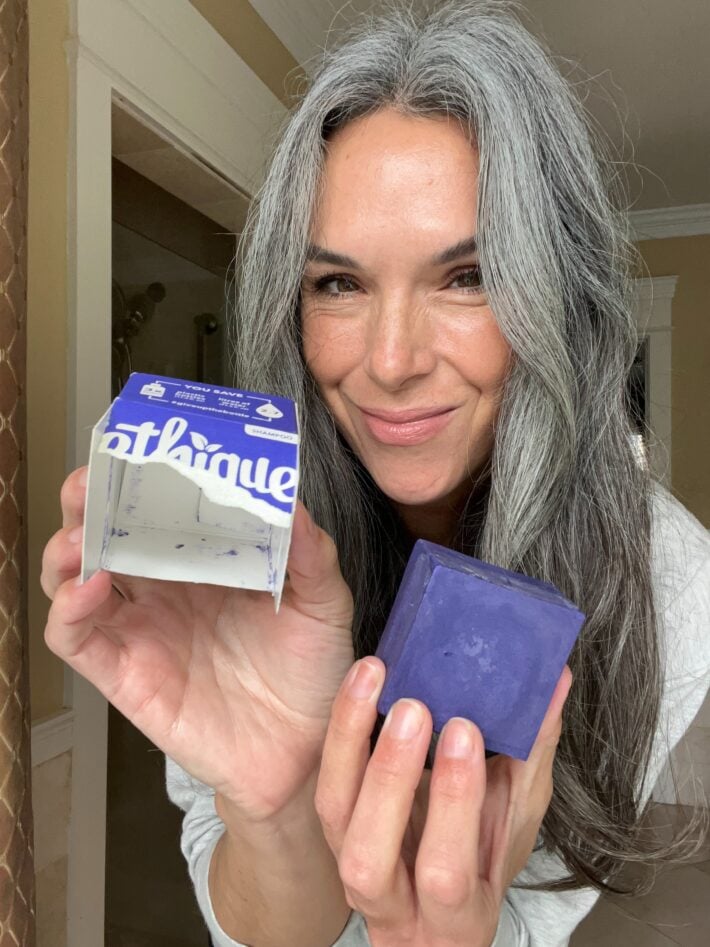
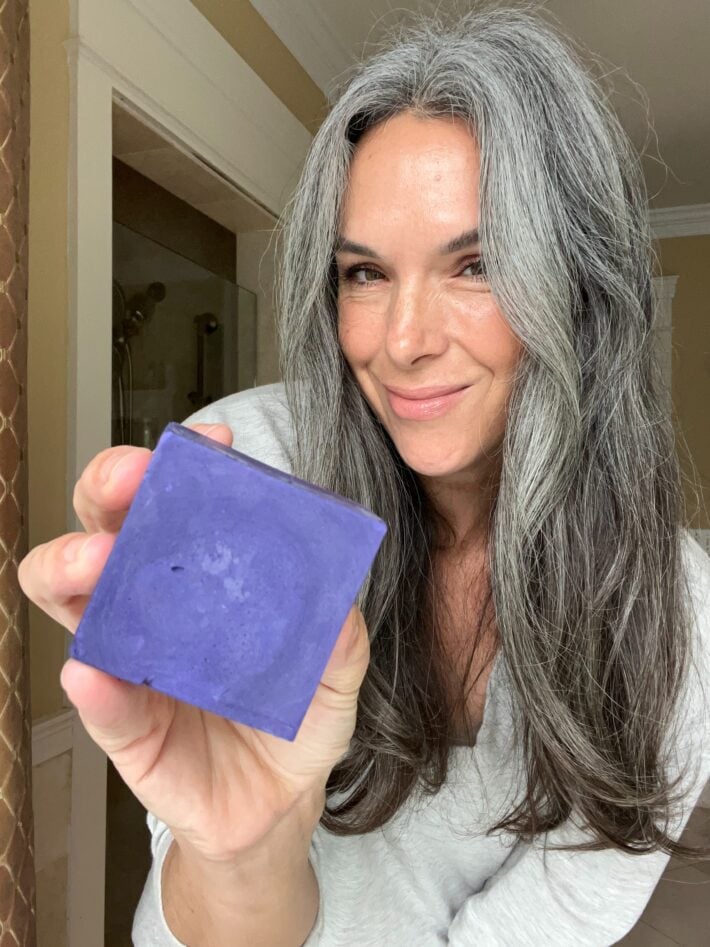
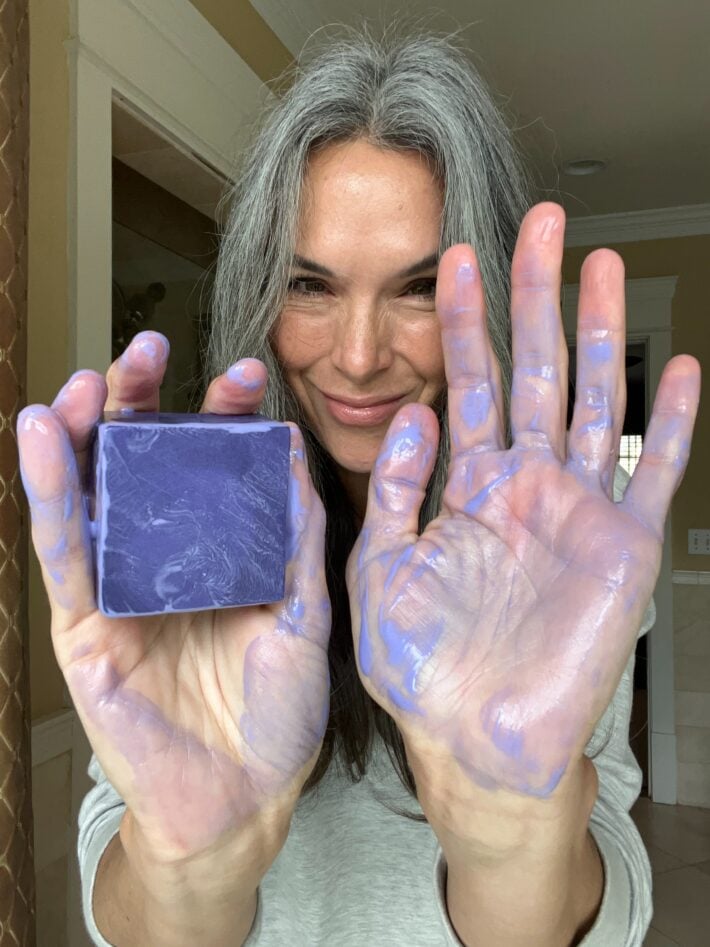
Ethique Tone It Down Brightening Purple Shampoo Bar | $17
The Ethique Tone It Down purple shampoo bar is another option that does not employ synthetic dyes. Instead it uses a combination of beet root powder and mineral-derived pigment like ultramarines, iron oxide red and mica.
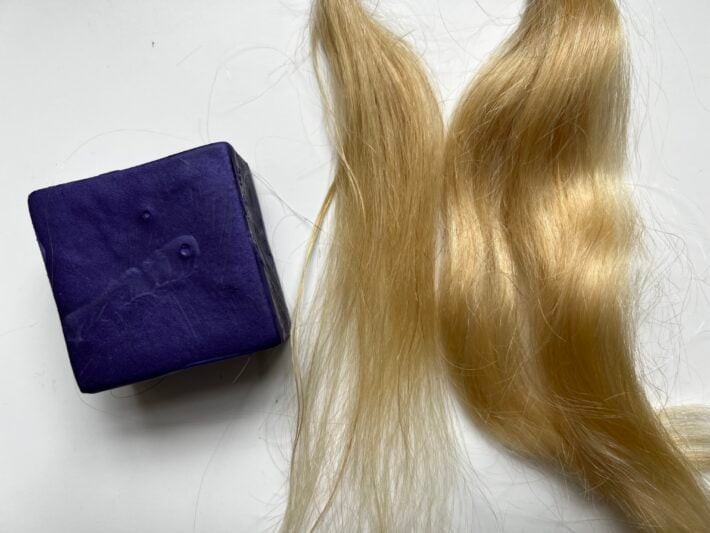
Love the sustainability efforts here, but as you can see the pigment transfer is a lot lighter than other shampoos, which has a direct impact on this shampoo’s ability to cancel out brassy tones compared to liquid purple shampoos. If we look at this product through the lens of efficacy, I didn’t find it to be even in the same ballpark as our top picks.
BEST FOR: Someone who values sustainability.
Ingredients: Sodium cocoyl isethionate, stearic acid, sodium cocoyl glycinate, mica, Theobroma cacao (cocoa) seed butter, Orbignya oleifera (babassu) seed oil, behentrimonium methosulfate, betaine, brassica alcohol, sodium isethionate, lactic acid, glycerin, guar hydroxypropyltrimonium chloride, parfum*, benzyl alchol, sodium chloride, aqua (water) dehydroacetic acide, Jasminum officinale (jasmine) oil, Beta vulgaris (beet) root powder, linalool, CI 77491, CI 77891, CI 77007
*We asked Ethique about the components of their fragrance, and they said, “Our Tone It Down bar features a COSMOS NATURAL certified fragrance containing Jasmine essential oil and vanilla parfum.” (And they shared the certification with us. *Two thumbs up!*).
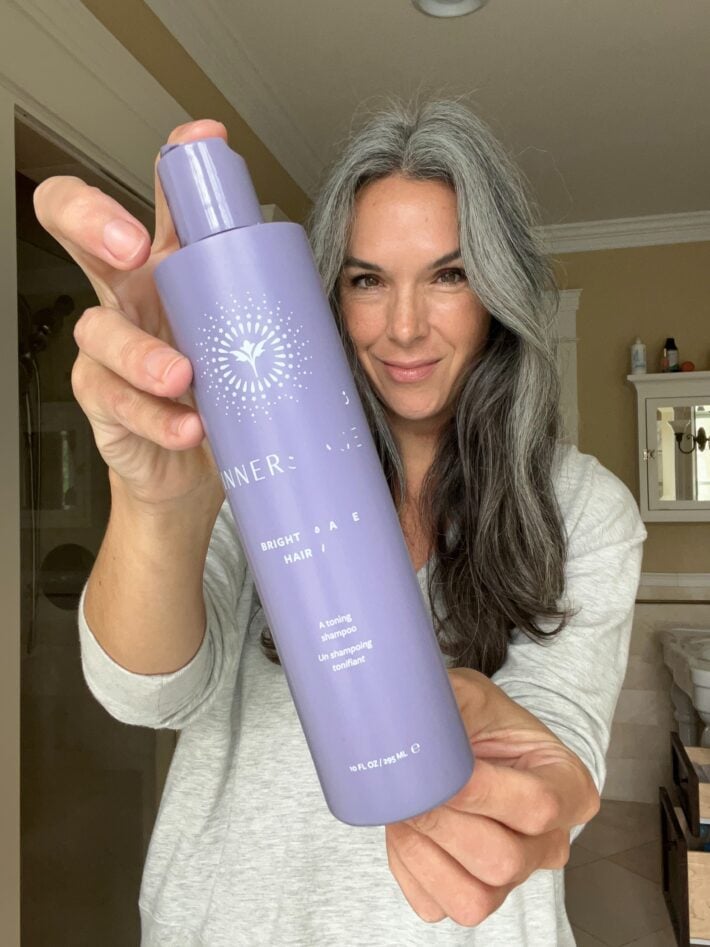
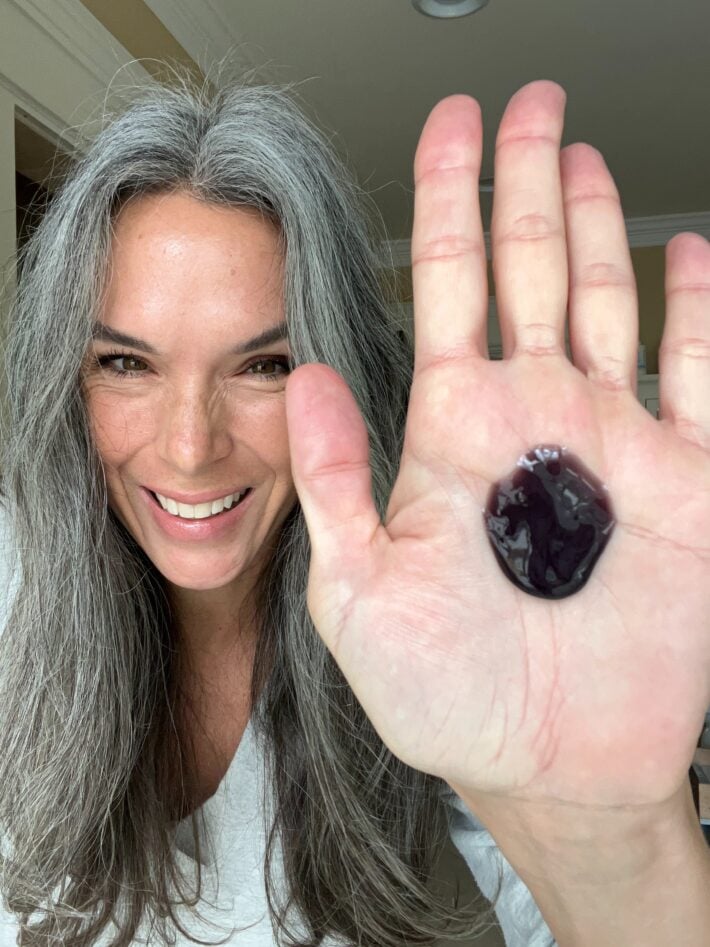
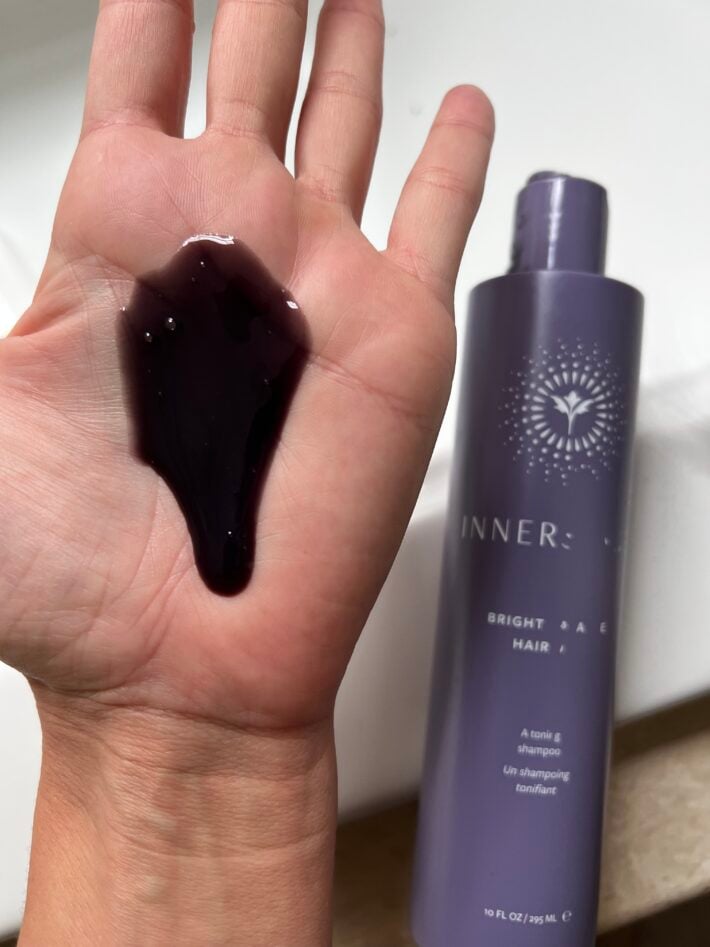
Innersense Bright Balance Hairbath | $30
This shampoo definitely works. It tones hair, period. If I leave it on for 5 minutes like the directions say, it definitely cancels out the brassiness—but it has more of a graying / steel color effect rather than a brightening effect. That can probably be adjusted by leaving it on for less time. You can also see that the shampoo color itself is a darker color purple than my top picks.
What’s interesting to me here is Innersense has chosen to use a mix of Basic Red and Basic Blue dyes to attain the purple color of this shampoo. That’s the same thing that color depositing shampoos like Overtone use (and we talked about above).
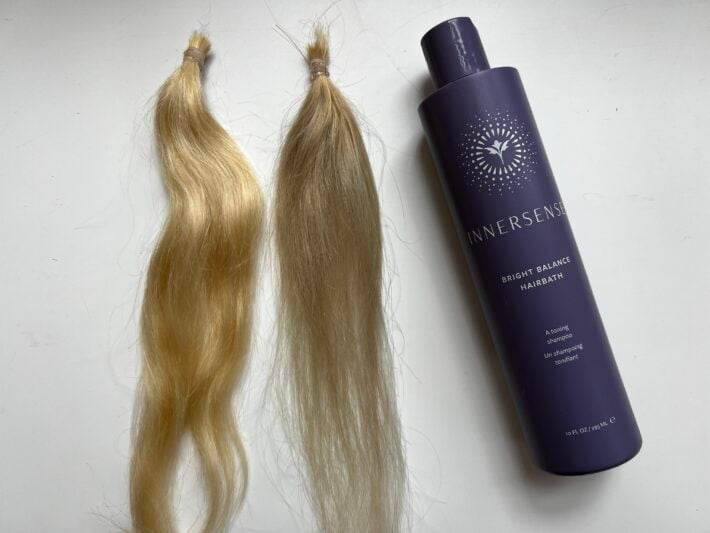
As far as the cleaning experience goes, it cleans my hair well without drying it out, which is consistent with every Innersense shampoo I’ve tried. The scent to me smells like a bouquet of white flowers…Gardenia? Jasmine? I don’t know and it’s hard to tell because most of the ingredient list consists of fragrance components.
BEST FOR: Someone who wants to try a new purple shampoo that works!
Ingredients: water/aqua/eau, cocamidopropyl hydroxysultaine, hamamelis virginiana (witch hazel) water, sodium cocoyl isethionate, glycerin, alcohol, caprylyl/capryl glucoside, glyceryl stearate se, guar hydroxypropyltrimonium chloride, sodium levulinate, potassium sorbate, citric acid, pyrus malus (apple) fruit extract, oryza sativa (rice) extract*, 2,6-dimethyl-7-octen-2-ol, orange terpenes, triethyl citrate, basic blue 99, sodium gluconate, basic red 76, hydrolyzed rice protein, butyrospermum parkii (shea) butter*, calophyllum inophyllum seed oil*, persea gratissima (avocado) oil, plumeria acutifolia flower extract, simmondsia chinensis (jojoba) seed oil*, allyl heptoate natural, alpha-terpineol, amyris balsamifera bark oil, anisaldehyde, benzyl acetate, beta-ionone, dimethyl heptenal, dodecahydro tetramethyl naphthofuran, eugenia caryophyllus (clove) leaf oil, eugenol, gamma decalactone, gamma nonalactone, gamma undecalactone, hexenyl acetate, hexyl acetate, hexyl cinnamal (hexyl cinnamic aldehyde), lemon oil terpenes, methyl benzoate, phenethyl acetate, phenethyl alcohol, raspberry ketone, rosmarinus officinalis (rosemary) leaf oil, vanillin, hydrolyzed quinoa, taraxacum officinale (dandelion) leaf extract, melissa officinalis leaf extract, salvia officinalis (sage) leaf extract, coconut acid, sodium isethionate, sodium benzoate, benzyl alcohol, citronellolᵻ, limoneneᵻ, linaloolᵻ
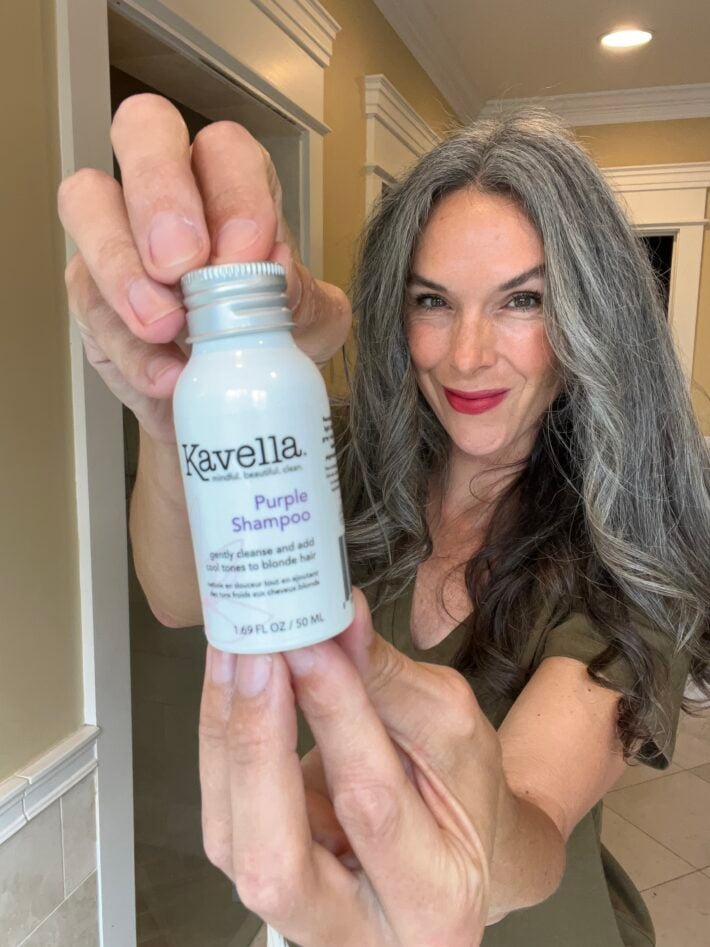
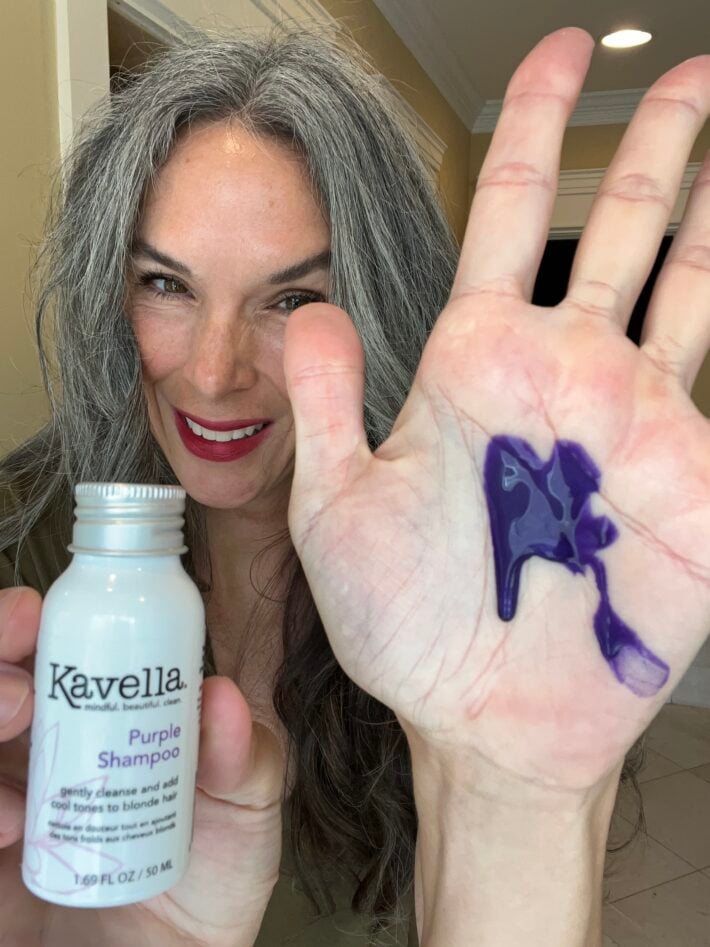
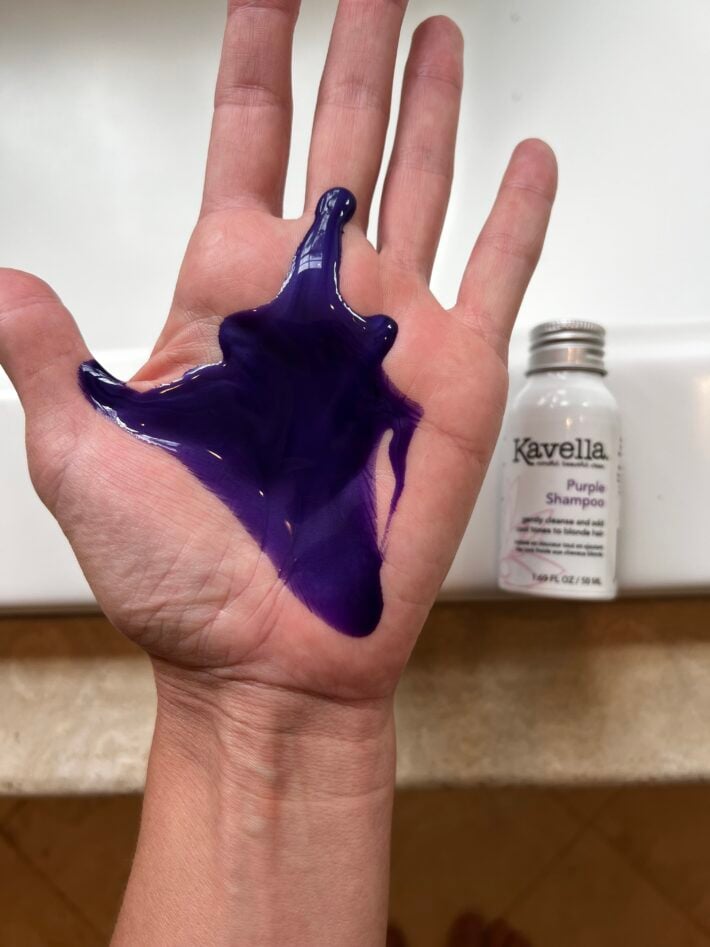
Kavella Purple Shampoo | $12
A reader asked me if I had tried Kavella and I hadn’t, so I ordered a sample (more photos to come). Kavella uses Acid Violet 43 and Acid Red 33 as colorants in a cleaner base. I love how pigmented this formula is, however I’m not recommending it for two reasons. This formula was super thin, runny and hard to manage. And it uses lower foaming agents as the primary and secondary surfactants so it NEVER foamed up for me—not even after three rounds of washing.
Call foaming/sudsing shampoo a personal preference, but I will go out on a limb and say most people feel the same. HOWEVER, if you are someone who prefers a shampoo that does not foam at all—then this one could be a good match for you.
BEST FOR: People who have a dry scalp or dry hair.
Ingredients: Aloe Barbadensis Leaf Extract*, Sodium Cocoyl Glycinate, Cocamidopropyl Hydroxysultaine, Decyl Glucoside, Cocamidopropyl Betaine, Glycerin*, Sucrose Cocoate, Leuconostoc/ Radish Root Ferment Filtrate, Glycol Distearate, Hydrolyzed Jojoba Protein, Gluconolactone, Guar Hydroxypropyltrimonium Chloride, Polyquaternium-10, Hydrolyzed Jojoba Esters, Potassium Sorbate, CI 60730 Acid Violet 43, Prunus Armeniaca L. (Apricot Kernel) Essential Oil, Citrus Paradisi (Grapefruit) Essential Oil*, CI 17200 Acid Red 33, Dipteryx Odorata (Tonka Bean) Absolute*, Citrus Grandis (Grapefruit) Peel Oil*, Lactic Acid, Benzaldehyde**, Benzyl Alcohol**, Cinnamal**, Limonene**, Linalool**, Benzyl Benzoate**, Coumarin**, Eugenol**
*organic **natural components of our apricot kernel essential oil and tonka bean absolute
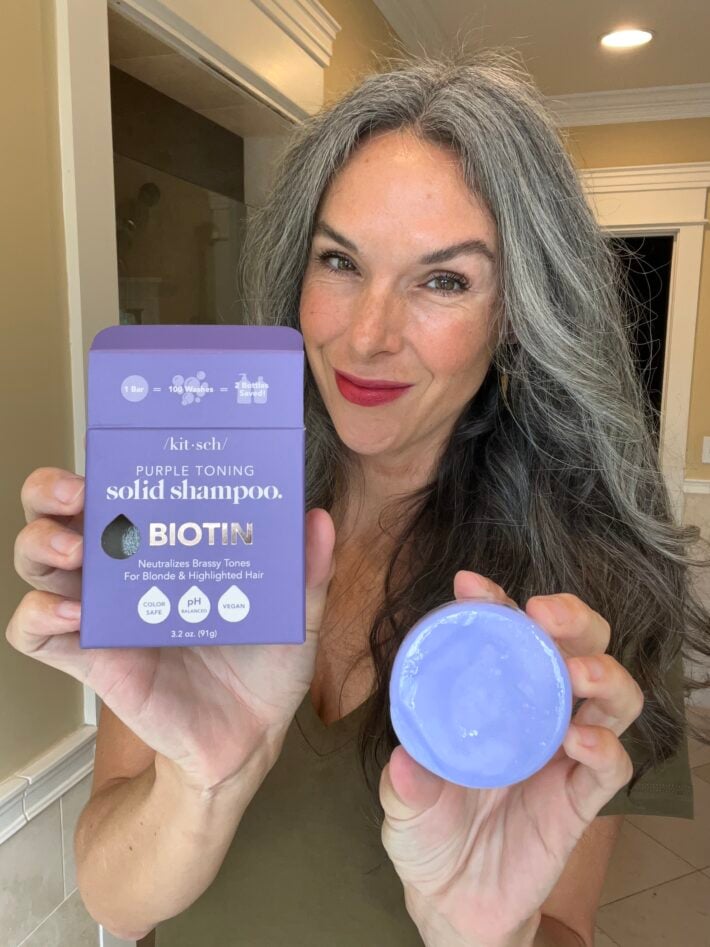
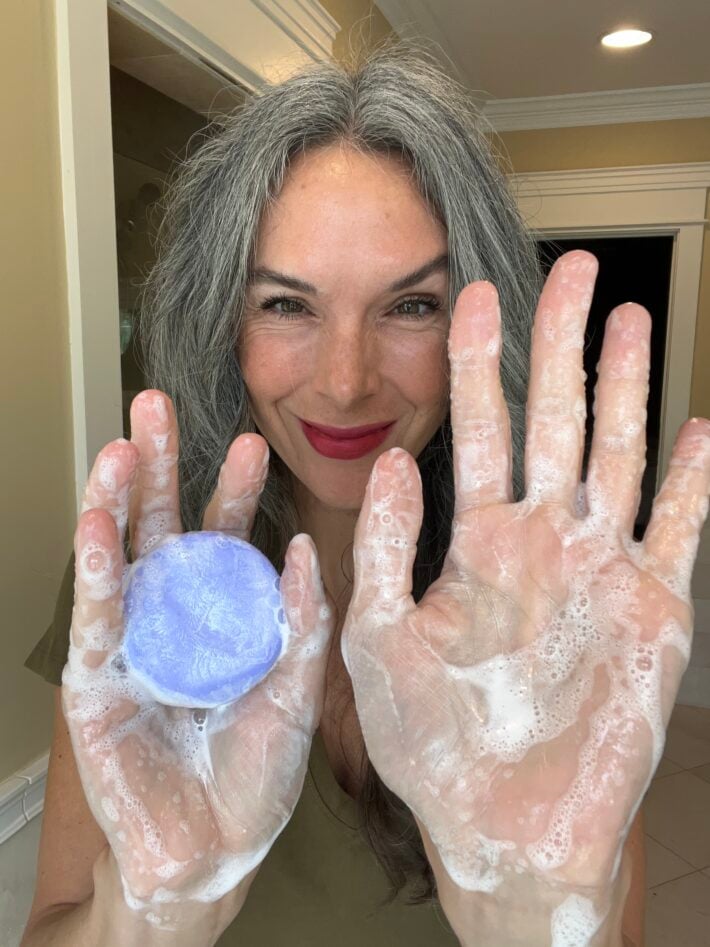
Kitsch Purple Toning Solid Shampoo | $14
I’m throwing Kitsch’s Purple Toning Solid Shampoo Bar into the mix because I wanted to see how a bar that uses synthetic dyes measures up. I was drawn to this bar specifically because of its simple ingredient list, including Violet No. 2 as a dye and Biotin to boost shine, reduce dullness & strengthen your hair.
The directions here say to wet hair and then “paint” on from lengths to ends for even toning. But what I can tell you (and what you can see CLEARLY in this image above) is that this purple shampoo bar foams up WHITE and color does not transfer at all.
On the other hand, I loved how this bar cleaned my hair. It left my hair and scalp feeling fresh, but not stripped. However, it did not make my gray hair more brilliant or neutralize any brassiness.
BEST FOR: Someone who values sustainability and clean hair.
Full ingredient list:Sodium Cocoyl Isethionate, Sodium Methyl Cocoyl Taurate, Vegetable Glycerin, Hydrogenated Castor Oil, Guar Hydroxypropyltrimonium Chloride, Natural Fragrance*, Biotin (Vitamin B7), Violet No. 2 (CI 60730). *Natural fragrance derived from plants (Orange Blossom & Jasmine).
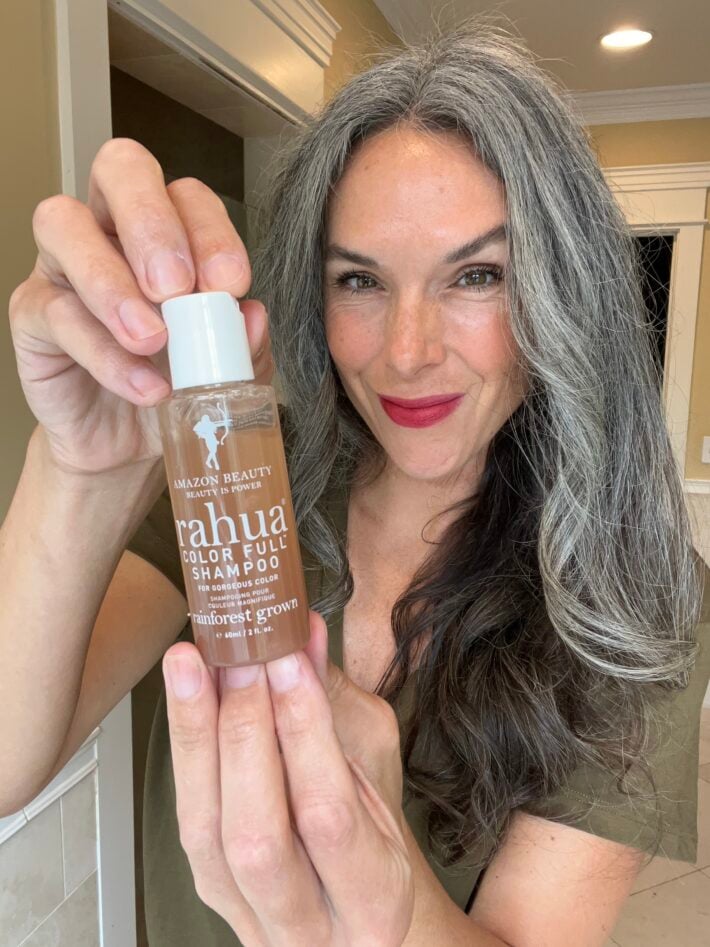
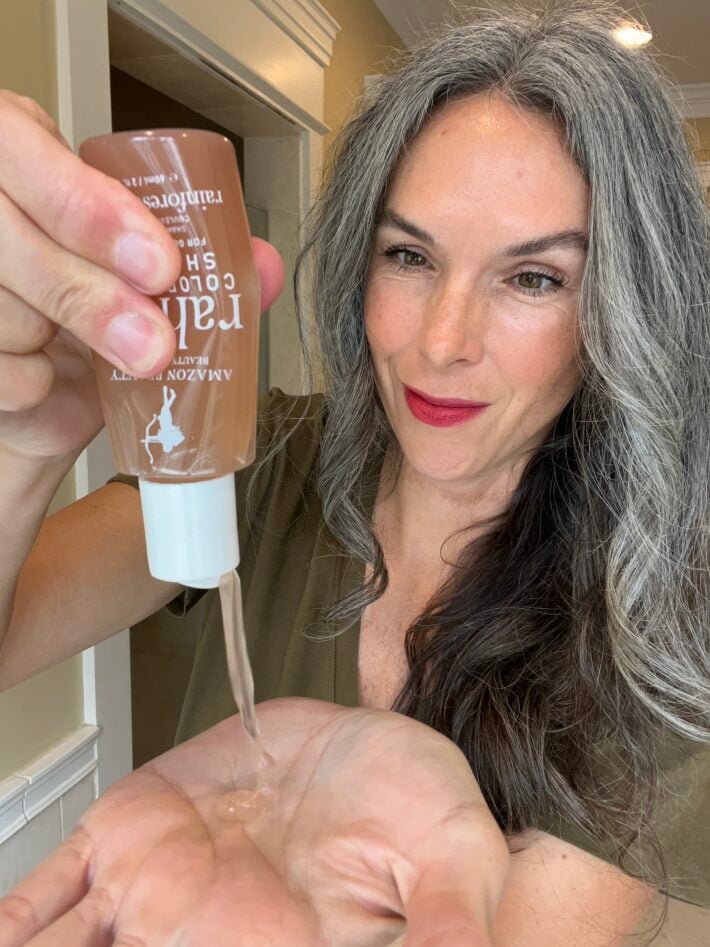
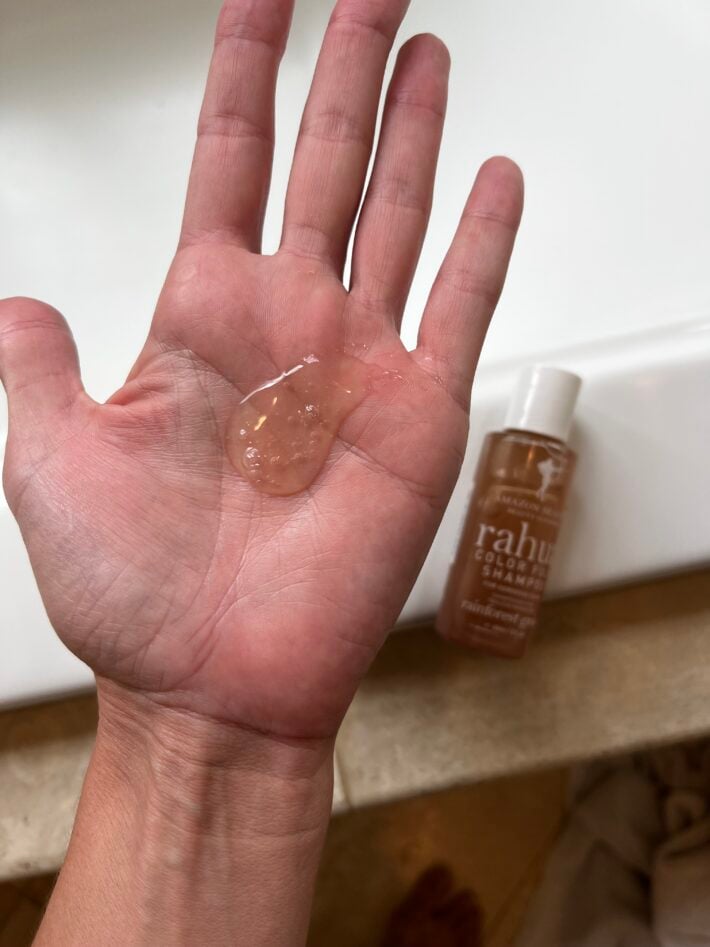
Rahua Color Full Shampoo | $38
Let me start out by saying I love Rahua. The entire brand is formulated around the foundational ingredient rahua oil, which indigenous Amazon women have used for years to nourish their hair and skin.
Their Color Full line is similar in mission to the EverEscents Organic Berry Blonde line: it’s not designed to tone gray hair, but to “preserve hair coloring” for “all shades of color-treated and highlighted hair.” This is more like a “color safe shampoo” for people who dye their hair.
I tried this shampoo and it did not brighten or whiten my grays, which makes sense because as a “color safe shampoo for all shades of color treated hair,” there are no FD&C dyes or active toning agents.
In my eyes, this formula is really designed to preserve color rather than neutralize brassiness, so if you are looking for that, this would be a great option for you.
BEST FOR: Someone trying to maintain their hair color in between salon visits.
Ingredients: Aqua, Herbal Infusion of Organic Aloe Barbadensis Leaf Extract, Organic Hibiscus Sabdariffa Flower Extract, Eclipta Prostrata (King of hair) Extract and Organic Vacciniumm Myrtillus (Bilberry Fruit) Extract, Sodium Alpha Olefin Sulfonate, Coco Betaine*, Sodium Cocoyl Isethionate*, Sodium Chloride (Sea salt), Organic Ocimum Basilicum (Sweet Basil) Extract, Vegetable Glycerin, Gardenia Jasminoides (Gardenia Enfleurage) Oil, Aroma, Organic Moringa Oleifera Seed Oil, Cyamopsis Tetragonoloba (Guar) Gum, Kaolin Clay, Zinc Oxide, Sucrose Extract, Mauritia Flexuosa Morete) Fruit Oil, Oenocarpus Bataua (Rahua Unguarahua) Oil, Linum Usitatissimum (Flax) Seed Oil, Helianthus Annuus (Sunflower) Seed Oil, Hydrolyzed Quinoa, Vaccinium Macrocarpon (Cranberry) Seed Oil. *Denotes plant derived ingredient.
After reading this, most people bought…
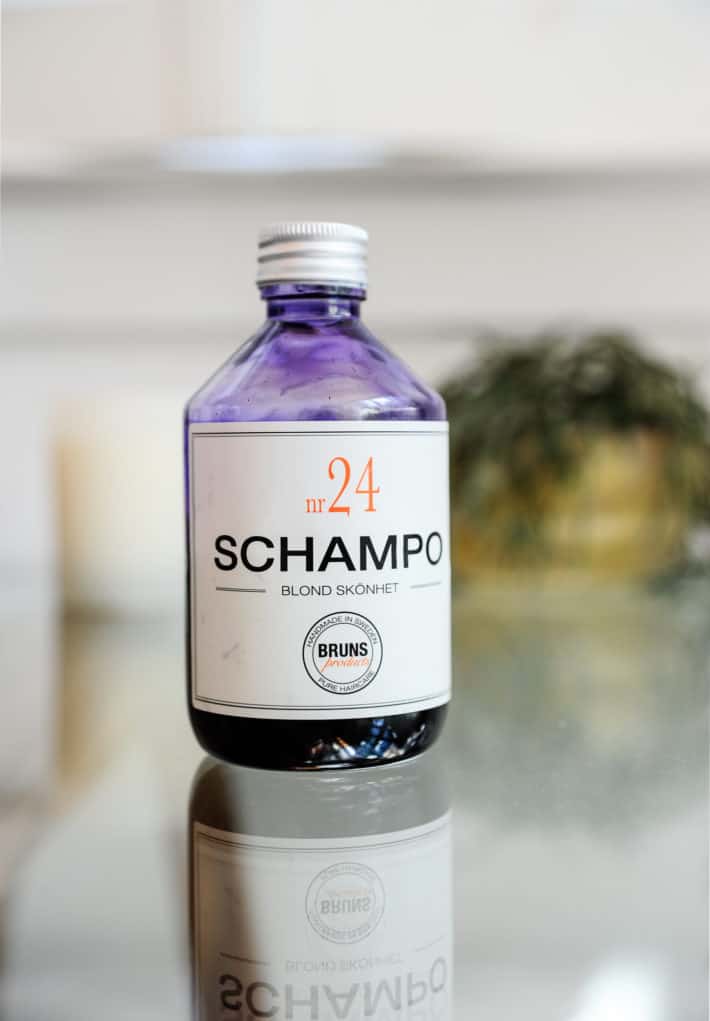
Bruns SCHAMPO N24 | $39
This purple shampoo is on the mild end of the spectrum—mild in cleansing power and milder in pigment. But it’s gentle enough to use every day, and it actually works to brighten and tone brassy strands. It works to clean without stripping or drying out hair, which is great considering hair gets naturally drier as we age. Especially gray hair!
Common questions about purple shampoos for gray hair
Purple shampoo is a shampoo containing purple pigment to neutralize yellow and brassy tones in gray and/or blonde hair. Learn more here.
There is no shortage of purple shampoos to choose from. These are some of better options (sans SLS, synthetic fragrance, parabens etc.) that I’ve tried.
Finding a “right fit” purple shampoo is really about taking into consideration your own type of hair and balancing that with how aggressive of a treatment you want. Check out my recommendations for natural purple shampoos.
Have you found a cleaner purple shampoo that works for you?
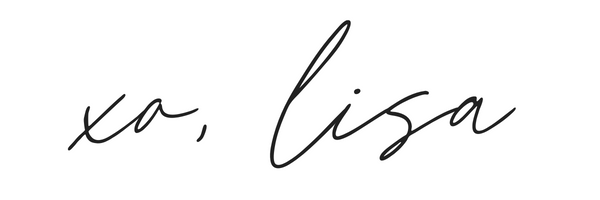
TNK Team Note: This article may contain affiliate links, including Amazon affiliate links. As an Amazon Associate, we earn from qualifying purchases. TNK uses affiliate links as a source for revenue to fund operations of the business and to be less dependent on branded content. TNK stands behind all product recommendations. Still have questions about these links or our process? Feel free to email us.

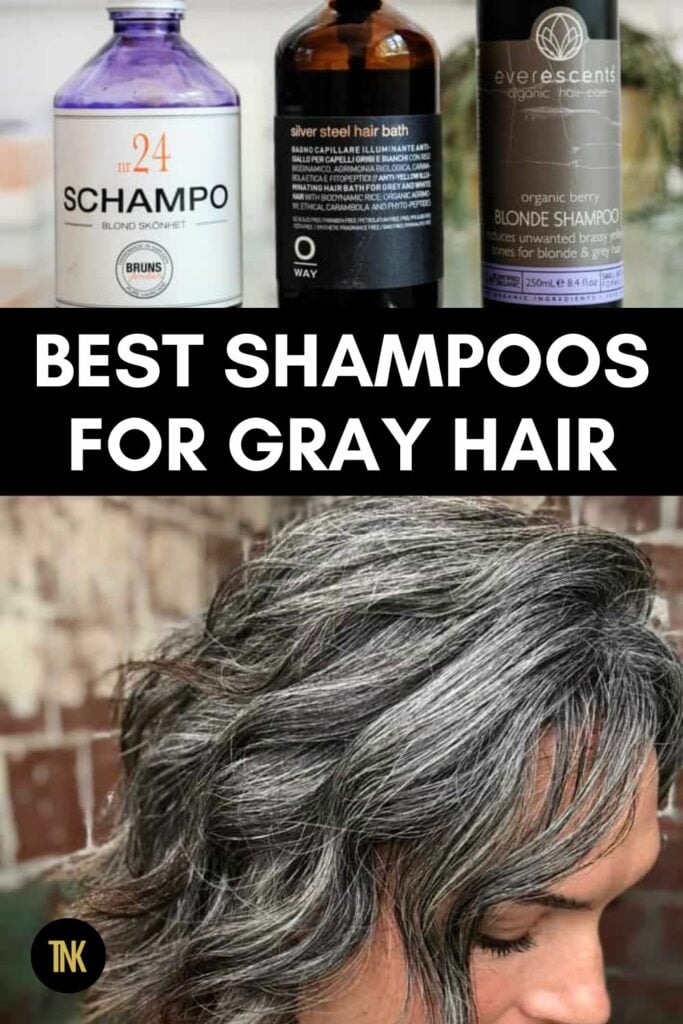
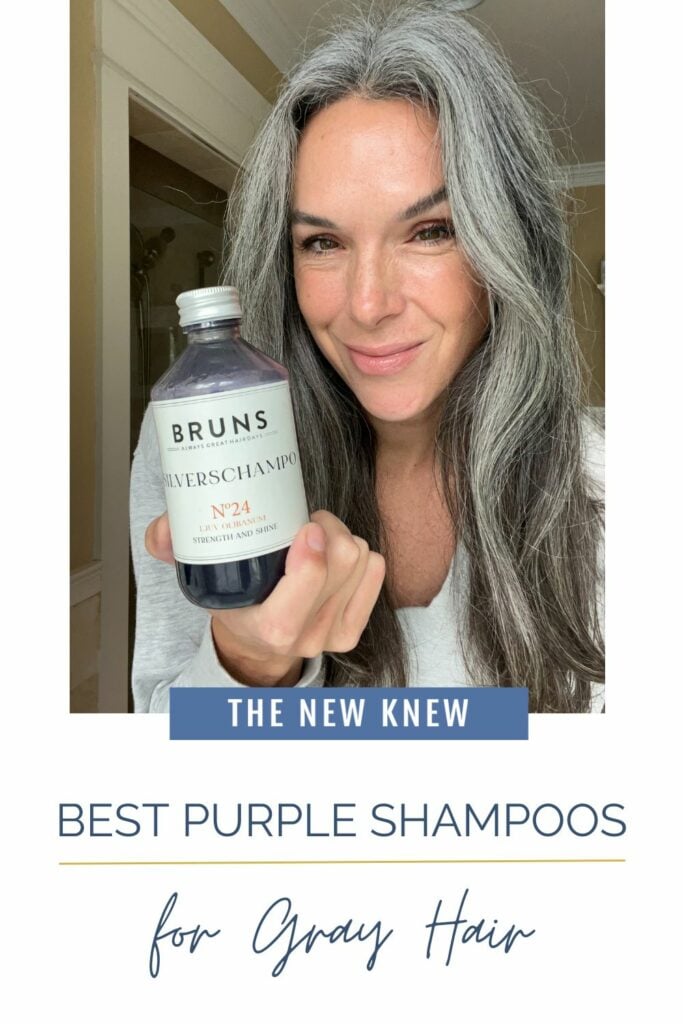
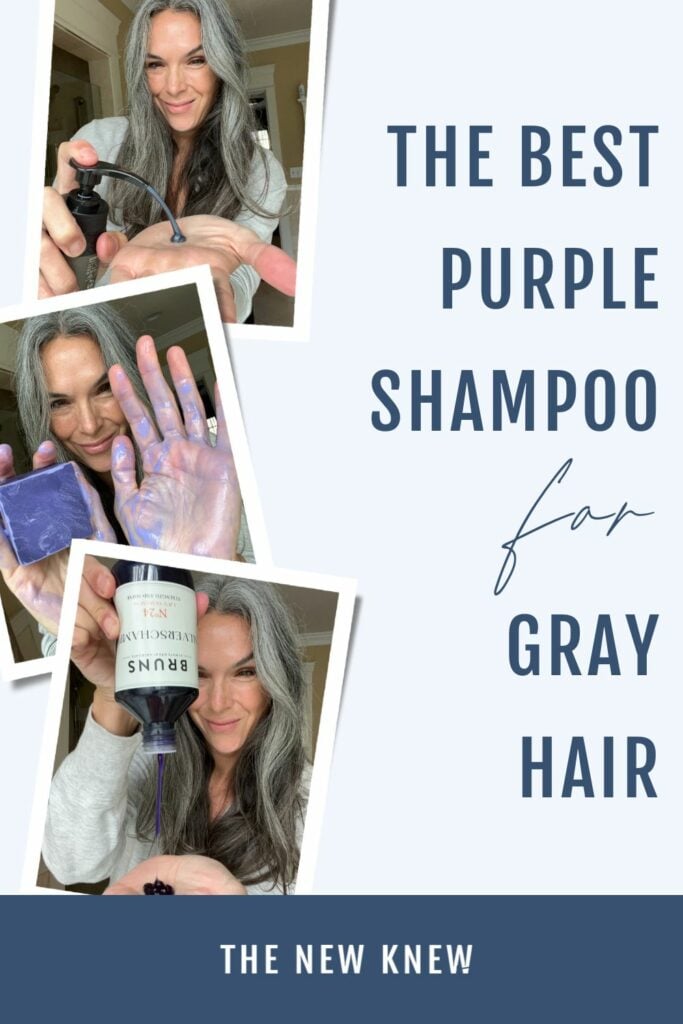
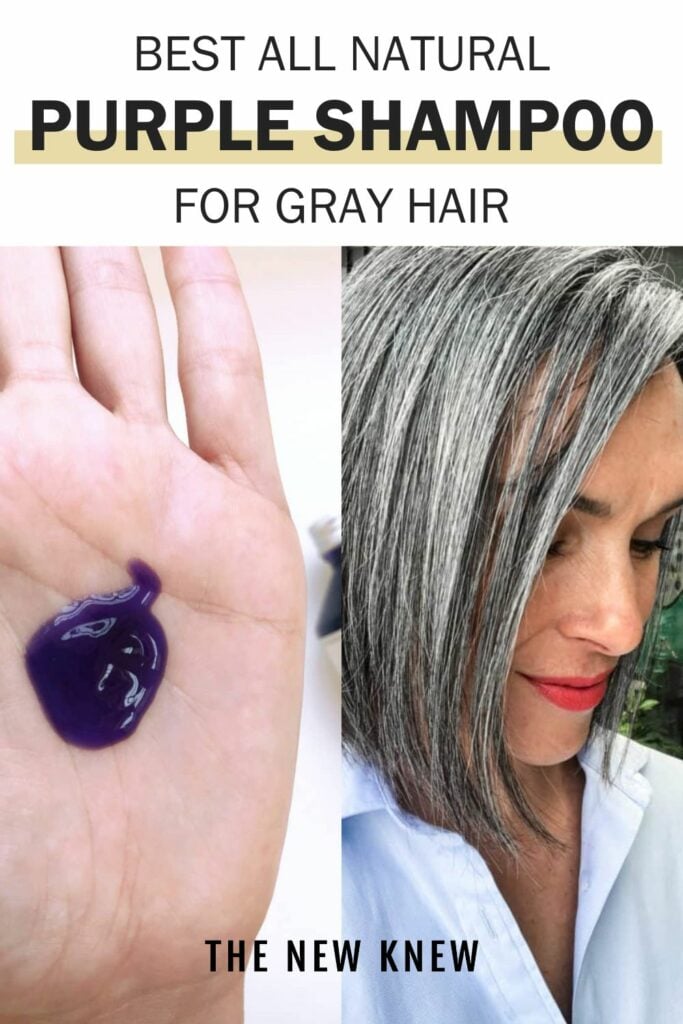
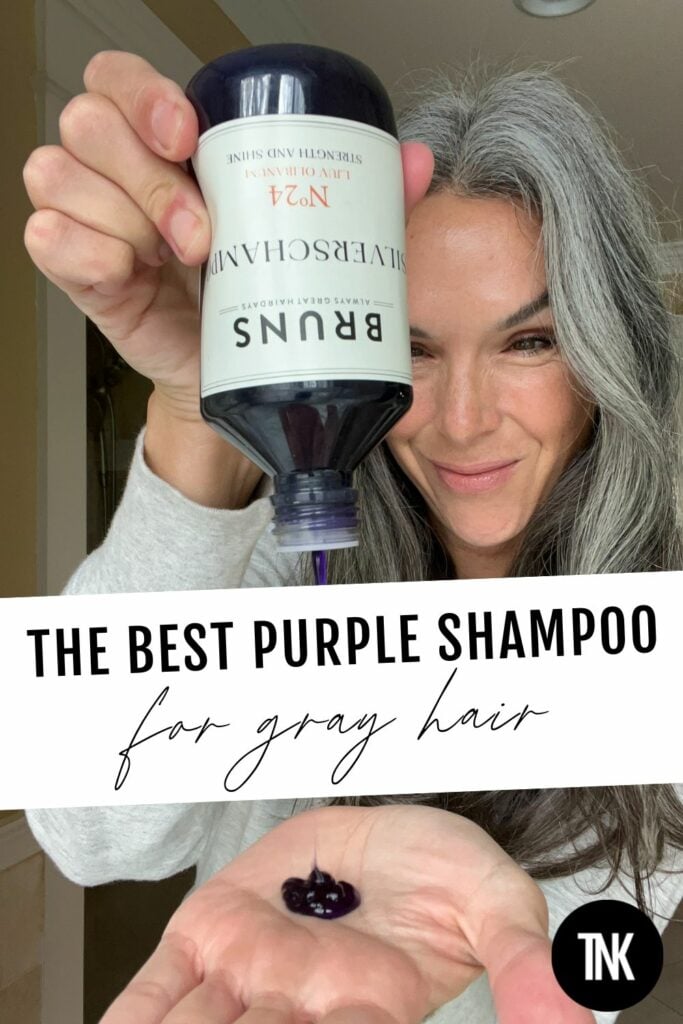
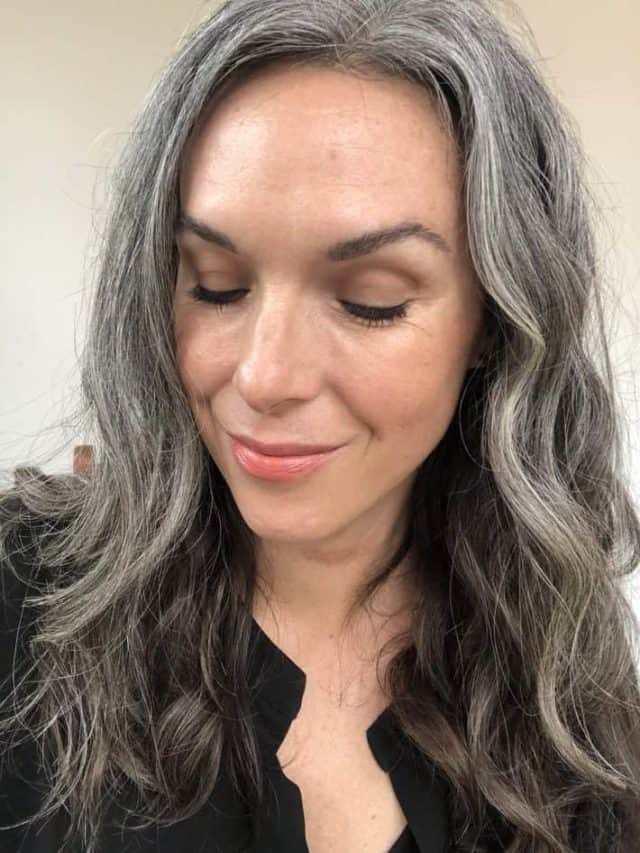
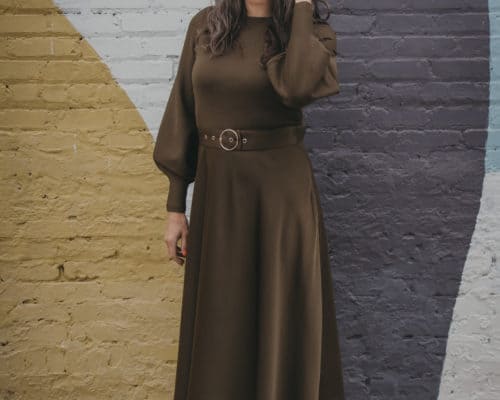
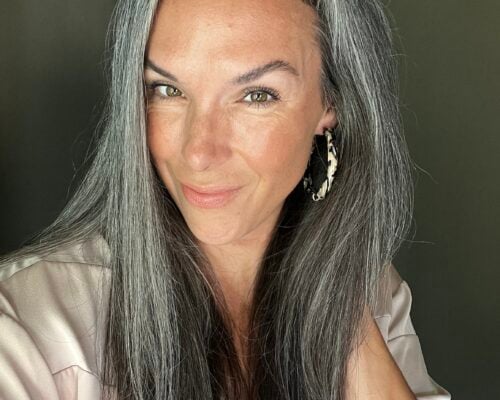
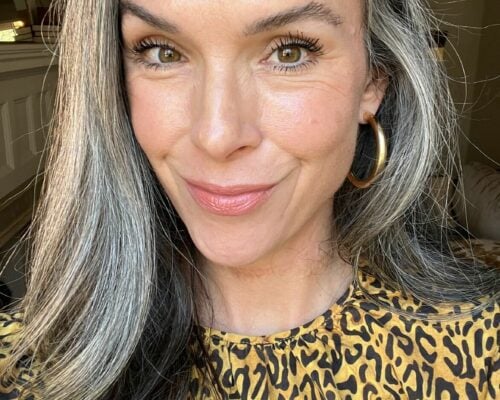
Wendy
April 10, 2023I hadn’t realized that. Thank you.
Wendy
April 10, 2023PS, can you recommend one that is scent-free?
Lisa Fennessy
April 17, 2023I haven’t used one that is scent free yet but when I come across one, I will be sure to note it here! xo, L
Suzanne
April 30, 2023It looks like Bruns now has a scent free option. Do you think you’ll carry it in your shop in the future? The shipping from Sweden is high.
Lisa Fennessy
May 3, 2023Yes! If readers want it, I will bring it in!
Ellen
May 17, 2023The purple shampoo I use is Shiny Silver Ultra conditioning shampoo by one n only..
I buy it at Sally beauty supply.
It cleans my slightly oily salt and pepper hair well, without dryness. Leaves my hair shiny, and bouncy after styling.
I always get compliments on my hair.
Jeannie Danford
June 17, 2023I’m wondering about Just Nutritive’s Gray Shampoo. Here are the ingredients. Would love your thoughts. Thanks, Jeannie
Aloe Barbadensis (Aloe Vera Hydrosol), Trifolium Pratense (Clover Flower) Extract, Psidium Guajava (Guava Fruit) Extract, Citrus Sinensis (Orange) Peel Oil, Persea Americana (Avocado) Oil, Punica Granatum (Pomegranate Seed) Oil, Hydrolyzed Rice Protein, Salvia Hispanica (Chia) Oil, Ribes Nigrum (Blackcurrant) Seed Oil, Decyl Glucoside, Sodium Methyl Cocoyl Taurate, Lavandula Angustifolia (Lavender) Oil, Rosmarinus Officinalis (Rosemary) Oil, Thymus Vulgaris (Thyme) Oil, Salvia Sclarea (Clary Sage) Oil, Guar hydroxypropyltrimonium, Glycerin, Pelargonium Graveolens (Rose Geranium) Oil, Methylcellulose, Caprylyl Glycol, Santalum Album (Sandalwood) Oil, Citric Acid, Panthenol (Vitamin B5).
Lisa Fennessy
June 23, 2023Hi Jeannie! This is an interesting find. Reviews on Amazon say they are happy with this product BUT I don’t see any agents here that would cancel out brassiness in gray hair. In fact this shampoo isn’t even purple. It’s an opaque color. I wonder what ingredient they are using to get rid of brassiness…? That would be my first question for the brand.
S Savage
July 20, 2023This model was in another grey hair ad for Earth Toner Darkening Shampoo Bar, so I don’t believe anything in this article.
Lisa Fennessy
July 24, 2023Hi! First of all, I’m not a model. My name is Lisa, and I run this blog, HI! Second, if that company is using my likeness, it is stolen imagery because I did not give them permission to do so.
obsessionwithoptions.com
August 18, 2023What an incredible journey you’ve taken us on through your blog post! 🌟 Your experimentation with nine different natural purple shampoos for gray hair, complete with before and after pictures, is an absolute goldmine of information for those looking to enhance and maintain their beautiful gray locks.
Your dedication to testing and reviewing these products shines brightly through your writing. The level of detail you provide, from the initial condition of your hair to the visible transformations after using each shampoo, is truly remarkable. Your honesty about the process and the effectiveness of each product is both refreshing and invaluable for your readers.
The inclusion of before and after pictures adds a visual dimension that brings your experience to life. It’s evident that you’ve put time and effort into showcasing the results, and the impact is undeniable. Your commitment to transparency and authenticity sets a high standard for beauty bloggers and reviewers.
Kathy
September 2, 2023Hello, I am looking for a purple shampoo that will leave a purple tint in my gray hair. The gray is in front and on top but I still have dark brown hair. What is your suggestion? I am new to this purple shampoo.
Lisa Fennessy
September 22, 2023Hi Kathy! You could try using Overtone. I know a lot of people use that to tint their hair purple. We have some before and after pics and more on Overtone in this post. Hope this helps! xo, Lisa
Stephanie
September 6, 2023I was wondering if a purple conditioner is also necessary if using a purple shampoo. I see that OWAY only offers a Frequent Use conditioner.
Thank you for all your time and effort you put into your work!
Lisa Fennessy
September 22, 2023Hi Stephanie! Great question. It’s really individualistic depending on what your hair goals are. Sometimes I use both purple shampoo and purple conditioner. Sometimes I use a regular shampoo and a purple conditioner and sometimes a purple shampoo and regular conditioner. I mean there are no rules here. If you want more brilliance, use both. But if I were to pick only one purple product to use it would be conditioner over shampoo simply because it stays on the hair longer. BUT (!) most conditioners are not as pigmented as the shampoos are so then if you used the shampoo and left it on longer (like a conditioner) you would get more out of that than a conditioner lol. I hope I didn’t just make this super complicated. Basically you can’t go wrong. xo, Lisa
Heather
October 15, 2023Actually, reading the thought process on this helped me decide to start with conditioner first and make my way up to shampoo, if needed. Thanks for that little journey you took us on. 🙂
Lisa Fennessy
October 17, 2023Of course! Let us know if you land on something you love! xo
Shane Roberts
October 27, 2023Lisa, i am a mostly silver with still some darker haired, man and was wondering if N°24 SILVERBALSAM, 330 ML (conditioner) and shampoo would be the best option for me. I have long hair that I wear back a lot of days and typically wash and condition twice a week. Thank you!
Lisa Fennessy
October 27, 2023Hi Shane! The benefits of the N°24 SILVERBALSAM are: 1. It’s moisturizing and won’t strip hair so if you have a dry or itchy scalp or dryer hair this will be a good moisturizing option for that. It’s not a great fit for people with oily hair because it’s more on the milder side. 2. It’s purple so it will help cancel out any brassiness. If you have brassiness or yellowing in your hair this will help brighten strands. If not, you don’t need a purple shampoo. 3. It has healthier ingredients than most purple shampoos – if you value that. Hope this helps!
Chantal
January 8, 2024I can also add Shikai Color Reflect Platinum Shampoo to this list. I love the brand and their Color Reflect line really works.
Holly
January 16, 2024I like the Shikai one too – not too much scent either. And easier to get where I live. And cheaper 🙂
Amy Goff
April 5, 2024What type of conditioner do you use?????
Lisa Fennessy
April 9, 2024Hi Amy! I like the Bruns purple Hairmask – have you tried it? Sometimes I’ll just use a non-purple shampoo but then use a purple conditioner to help brighten. Conditioner is everything imo bc it stays on longer!
Amy
April 9, 2024I will have to try it. thanks